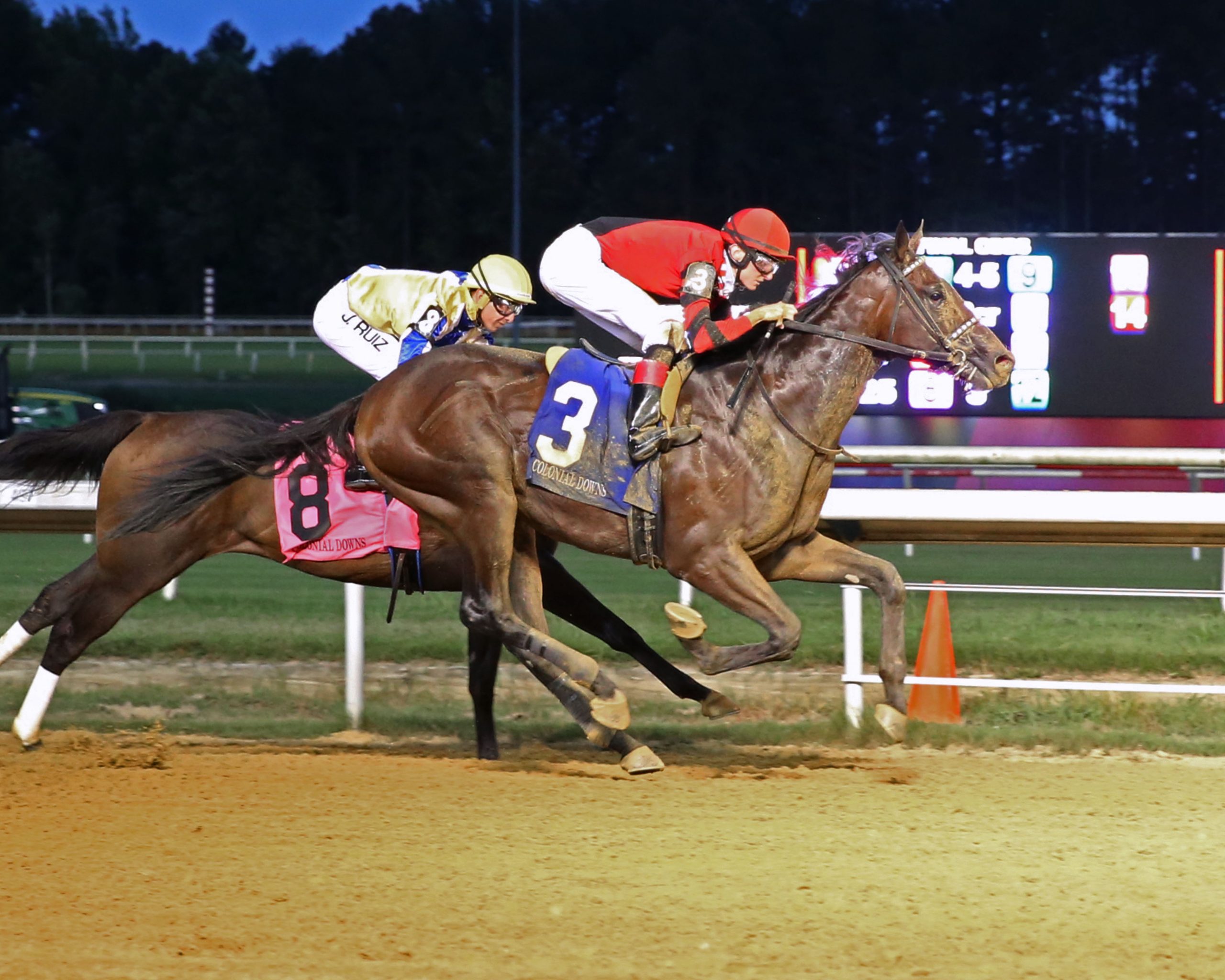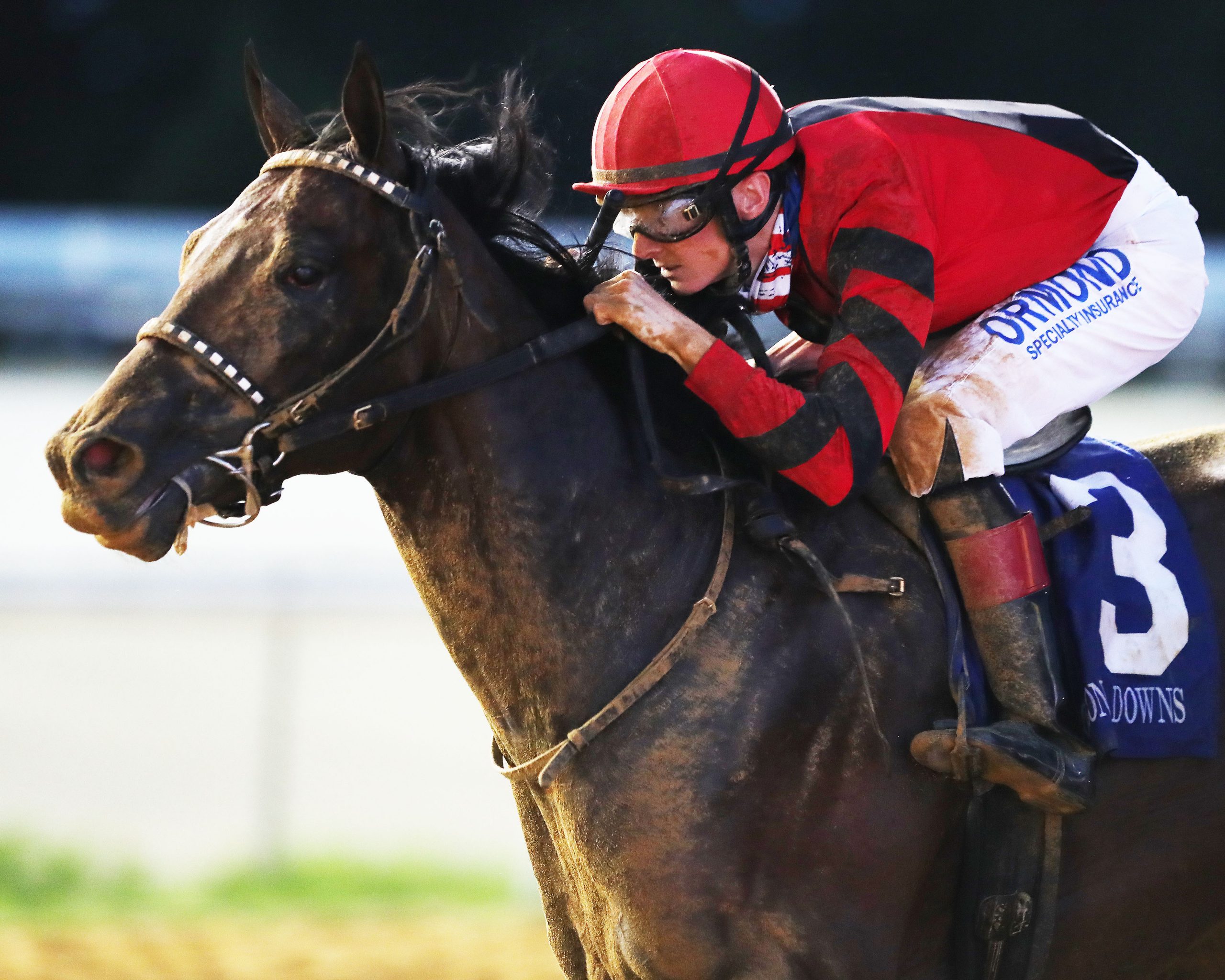Author Archives: Darrell Wood
Colonial’s Wednesday Race Card Taken Off the Turf; Post Time Moved Up To 5:00 PM
Jockey Trevor McCarthy Has Five Wins Sunday at Colonial Downs
The 26-year-old native of Wilmington, Delaware won the jockey title at Colonial last year as the New Kent track returned to action after a six-year absence. He entered Sunday’s card — a makeup from last Monday’s cancellation — with five wins from 16 starts, just two days into the 2020 season. Forest Boyce was one better though, having won six times.
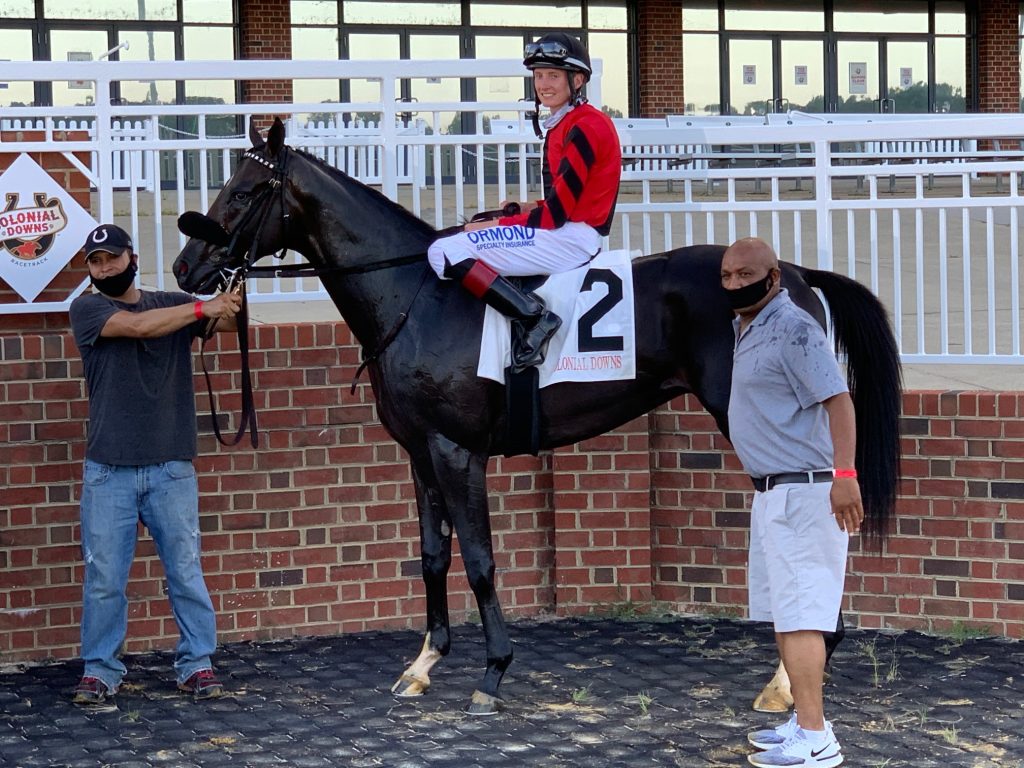
McCarthy connected early with Ferris Allen’s No Knock Raid in the second, then won three straight beginning in the fourth. He was atop Michael Campbell’s Sky Mischief, Michael Stidham’s Palio and Sarah Nagle’s Cark over that span.
McCarthy, leading rider leader in Maryland in 2014 and 2016, closed out his evening by guiding Wesley Ward’s Sunshine City to victory in the 5 1/2 furlong eighth. “I was worried a bit in the turn but when I asked her to respond, she did. It was like pushing a button. I just tried not to overthink the ride.”
Boyce prevailed once on Sunday with Princess Grace so after three race days, McCarthy has ten wins to Boyce’s seven. On Monday, the pair have eight and six mounts respectively in Colonial’s nine race card.
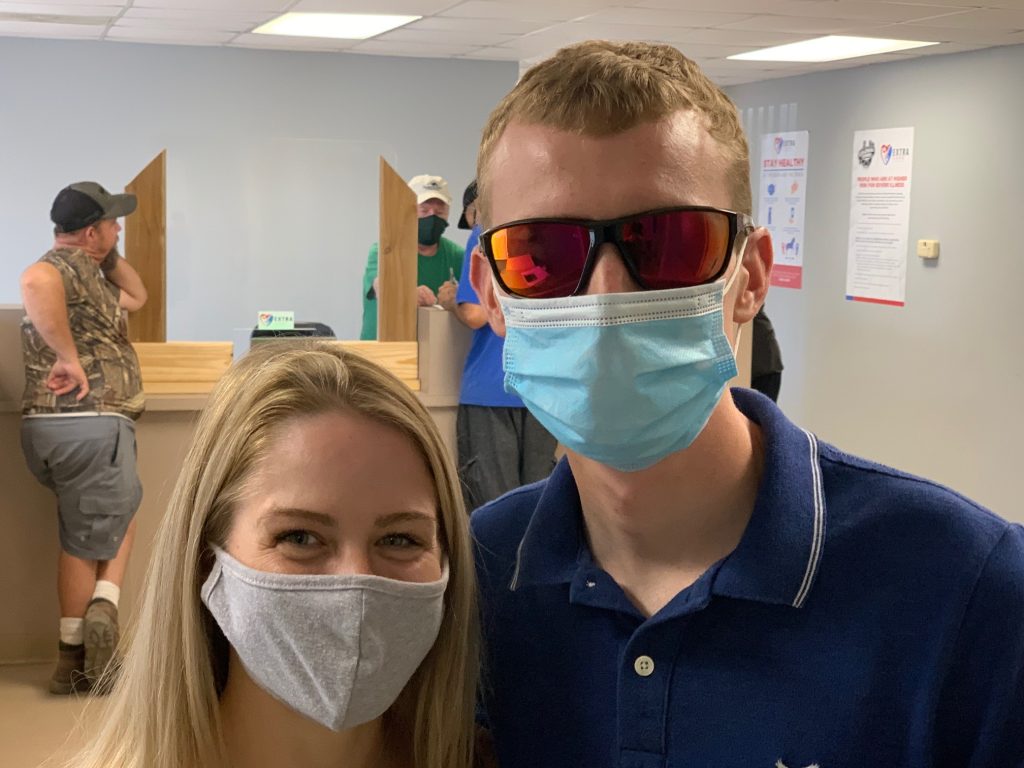
McCarthy was humble when asked about his early season success. “I can’t take the credit,” he said. “I give credit to the trainers and all the great staff involved behind the scenes, from exercise riders, to grooms, to hotwalkers. My agent (Scott Silver) has been picking the right horses for me to ride and the horses have been doing what they’re supposed to do. I’ve gotten great support from my family and future wife (jockey Katie Davis).
Colonial Downs, in its second season under ownership of the Colonial Downs Group, continues its summer meet through September 2. Racing is held every Monday, Tuesday and Wednesday at 5:30 PM. Highlight of the season is the New Kent County Virginia Derby Night on Tuesday September 1.
Meet Jump Race Titan Peter Howe & His Daughter Jill Byrne, Colonial VP of Racing Operations
The following was written by Betsy Burke Parker and appeared in an e-mail newsletter to the steeplechase community. The theme is “Legends of Steeplechasing” and title is, “Jill Byrne: The story of me and my Dad & how it come to be that I am here at Colonial Downs”.
A titan in a time of jump racing giants, Virginia-based trainer Peter Howe knew the importance of bloodlines in the thoroughbred world 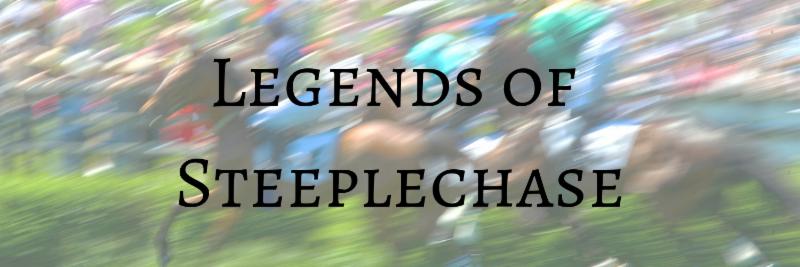 By Betsy Burke Parker. By Betsy Burke Parker.
A racehorse riddle: What’s the X-factor when it comes to producing a champion? Nature or nurture? Peter Howe (©Douglas Lees) knows from experience that it’s a blend of science and art, but he says all of it is required to attain premium performance. He recognized the duality over a 40-plus year career training multiple champions out of Marion du Pont Scott’s Montpelier – they were born to it, and he sees it now in daughter Jill Byrne – raised from day one with the skillset to have her hand on the helm of Virginia’s Colonial Downs. In the best horses, Howe says, as with daughter Jill, he learned early to recognize that uncanny ability to leave long and land running. Literally with horses, figuratively with people. “Tingle Creek would do that,” says the 81-year-old trainer, still elegant and upright at 6 feet and still living near his beloved Red Horse Farm in Barboursville, Virginia. The soft-spoken Howe has been retired from racing nearly 20 years, but he keeps up with it through friends, through Jill and through televised racing on TVG. “You’d have to be a very good horse to get away with standing off like that,” Howe says. He had years in the show ring and jumped thousands of show fences to develop this precision sense of timing. “Tingle Creek, Soothsayer, Neji. Horses like that could do it. It takes a good athlete with a lot of courage. “Other trainers would sometimes try and send out a ‘rabbit’ as an entry to try and hook up with Tingle Creek to pressure him into making a mistake. That never worked.” As for his daughter, Howe says she’s done a masterful job recreating the long-shuttered Colonial Downs, opened for the first time last year after it last hosted racing in 2013. “It took courage there, too,” he says. “She’s always been her own person, I saw that when she was just a kid working in the barn. She’s really showed what she’s made of helping bring that place back.” As the Colonial Downs meet gets underway in central Virginia this week – including jump races scheduled every Monday plus a special make-up card this Sunday, we wanted to hear from the vice president of racing to see how it’s going at the summer turf festival, and we wanted to hear from her father Peter Howe, to learn how it all began a few miles down the road at Montpelier. |
Three of Peter Howe’s (and America’s) bestSoothsayerHowe calls four-generation Scott homebred, and 1972 Eclipse champion ‘chaser Soothsayer one of one of the greatest steeplechasers, ever. Third in his first bumper start, the athletic dark bay was second first out over hurdles – a 3-year-old ‘chase at Belmont Park, and won by 12 in a laugher at Fair Hill that September. It was a sign of things to come. He won at Belmont next start then was second to another standout juvenile that year, Inkslinger, in the Stoddard Handicap and at the Colonial Cup in November. “He was a helluva nice horse,” Howe recalls. “Classy. You could put him anywhere. On the front end, come from behind. He’d do it. Great jumper, not brilliant like Tingle Creek, but strong and fast.”  Soothsayer in 1972©Steeplechasing in America Soothsayer was sent to England after his 1972 championship kept the handicap weights high. Soothsayer’s first English start was the Mackeson Gold Cup at the November, 1974 Cheltenham fall meet. Soothsayer finished second in the Mackeson, third in the King George VI at Kempton Park in January, and second in a tail-wringing, uphill battle to the wire behind winner Ten Up in the Cheltenham. But there was a dirty little secret about Soothsayer, something that didn’t surprise Howe when he heard about it back home, and something he’d had to deal with himself on the American circuit. It eventually got Soothsayer sent back to the U.S. “Soothsayer was hell in the paddock,” Howe recalls the gelding was prone to washing out as he pranced and danced the instant he realized he was going to the races; he even needed a handler to ride on the van with him when shipping to soothe him as he trembled and fretted. “He was a nervous wreck. Good when you got on and got to work, but, my god, he was embarrassing in the paddock. “Those English trainers don’t like a horse like that.” Plus, Howe figures, English trainer Fred Winter “didn’t really know how to deal with Mrs. Scott.” He recalls the fiery relationship between Winter and small, outspoken American. “He expected her to act like the Queen. “She did not act like the Queen. “Mrs. Scott had her own opinions and made them known.” Soothsayer returned home to Virginia after the Cheltenham Festival, second in the 1975 Turf Writers that summer at Saratoga, winning the Laing at Montpelier that fall and third in his final start, the Colonial Cup. He won 11 of 26 lifetime starts and nearly $200,000. Soothsayer in 1972©Steeplechasing in America Soothsayer was sent to England after his 1972 championship kept the handicap weights high. Soothsayer’s first English start was the Mackeson Gold Cup at the November, 1974 Cheltenham fall meet. Soothsayer finished second in the Mackeson, third in the King George VI at Kempton Park in January, and second in a tail-wringing, uphill battle to the wire behind winner Ten Up in the Cheltenham. But there was a dirty little secret about Soothsayer, something that didn’t surprise Howe when he heard about it back home, and something he’d had to deal with himself on the American circuit. It eventually got Soothsayer sent back to the U.S. “Soothsayer was hell in the paddock,” Howe recalls the gelding was prone to washing out as he pranced and danced the instant he realized he was going to the races; he even needed a handler to ride on the van with him when shipping to soothe him as he trembled and fretted. “He was a nervous wreck. Good when you got on and got to work, but, my god, he was embarrassing in the paddock. “Those English trainers don’t like a horse like that.” Plus, Howe figures, English trainer Fred Winter “didn’t really know how to deal with Mrs. Scott.” He recalls the fiery relationship between Winter and small, outspoken American. “He expected her to act like the Queen. “She did not act like the Queen. “Mrs. Scott had her own opinions and made them known.” Soothsayer returned home to Virginia after the Cheltenham Festival, second in the 1975 Turf Writers that summer at Saratoga, winning the Laing at Montpelier that fall and third in his final start, the Colonial Cup. He won 11 of 26 lifetime starts and nearly $200,000. A tight contest in the 1973 Temple Gwathmey – International Gold Cup. Soothsayer (right) and Joe Aitcheson finished second to Athenian Idol (middle) and Jerry Fishback.©Steeplechasing in AmericaTingle Creek He was fancy enough to be a show-horse, but Tingle Creek was a big, tough gelding with the look of eagles, trainer Peter Howe recalls. He was born on owner Helen Whitaker’s Somerset, Virginia farm – equidistant from Howe’s Red Horse Farm in Barboursville and her buddy Marion du Pont Scott’s Montpelier estate in tiny Montpelier Station. Tingle Creek’s sire was Paul Mellon’s Goose Creek, a handsome grey that was sent to England but not before he sired a handful of useful runners including Mellon’s stakes-winner Aldie, Tingle Creek, and even Mellon’s Christmas Goose that won the 100-mile Homestead endurance ride with Mellon up. Tingle Creek didn’t ever win a championship, but Peter Howe maintains that he was perhaps the best horse he ever trained, and one of the world’s top ’chasers. This he recognized from the start. Helen Whitaker owned Tingle Creek’s dam, Martingle, who had produced multiple hurdle stakes winner General Tingle in 1959. So a lot was expected when her 1966 foal was born, a gangly chestnut colt with a wide white blaze and tall white socks on both left legs. He was a spectacular jumper, Howe recalls, thinking the young Tingle Creek was pretty nice as they broke him and started jogging and cantering on the Montpelier training track and on the grass on the infield. But it wasn’t until he schooled over the natural hedges at Montpelier that Howe realized he might be sitting on a unicorn. “I’ll never forget that morning,” Howe says. “I was on Tingle Creek. Noel Twyman was with me. He was on a young horse (both 3-year-olds) too. We had schooling jumps set where they park the cars now on the infield. “First time down to that jump – they weren’t small – Tingle Creek left a stride out. We pulled up, and I said to Noel – “I’ve got a horse here’.” It was something Tingle Creek did all the time – so long was his stride, so sure was his eye and so powerful were his quarters, he could easily leave outside the wings and land in a graceful gallop strides ahead of his rivals. A tight contest in the 1973 Temple Gwathmey – International Gold Cup. Soothsayer (right) and Joe Aitcheson finished second to Athenian Idol (middle) and Jerry Fishback.©Steeplechasing in AmericaTingle Creek He was fancy enough to be a show-horse, but Tingle Creek was a big, tough gelding with the look of eagles, trainer Peter Howe recalls. He was born on owner Helen Whitaker’s Somerset, Virginia farm – equidistant from Howe’s Red Horse Farm in Barboursville and her buddy Marion du Pont Scott’s Montpelier estate in tiny Montpelier Station. Tingle Creek’s sire was Paul Mellon’s Goose Creek, a handsome grey that was sent to England but not before he sired a handful of useful runners including Mellon’s stakes-winner Aldie, Tingle Creek, and even Mellon’s Christmas Goose that won the 100-mile Homestead endurance ride with Mellon up. Tingle Creek didn’t ever win a championship, but Peter Howe maintains that he was perhaps the best horse he ever trained, and one of the world’s top ’chasers. This he recognized from the start. Helen Whitaker owned Tingle Creek’s dam, Martingle, who had produced multiple hurdle stakes winner General Tingle in 1959. So a lot was expected when her 1966 foal was born, a gangly chestnut colt with a wide white blaze and tall white socks on both left legs. He was a spectacular jumper, Howe recalls, thinking the young Tingle Creek was pretty nice as they broke him and started jogging and cantering on the Montpelier training track and on the grass on the infield. But it wasn’t until he schooled over the natural hedges at Montpelier that Howe realized he might be sitting on a unicorn. “I’ll never forget that morning,” Howe says. “I was on Tingle Creek. Noel Twyman was with me. He was on a young horse (both 3-year-olds) too. We had schooling jumps set where they park the cars now on the infield. “First time down to that jump – they weren’t small – Tingle Creek left a stride out. We pulled up, and I said to Noel – “I’ve got a horse here’.” It was something Tingle Creek did all the time – so long was his stride, so sure was his eye and so powerful were his quarters, he could easily leave outside the wings and land in a graceful gallop strides ahead of his rivals.  Tingle Creek (Jerry Fishback, up) leading the field in the 1971 Noel Laing.©Douglas Lees Twyman got the call aboard Tingle Creek in his first start, a 3-year-old hurdle at Belmont Park. They finished a promising second – to Katherine Clark’s Augustus Bay, trained by Howe’s best friend, Sidney Watters. Tingle Creek failed to produce in four more tries at 3, so Howe put him away for the winter and brought out a freshened 4-year-old in 1970. Skip Brittle was a 7-pound bug when 15 went postward in the Tom Roby hurdle handicap over the lush Delaware Park that June 30. There was a breathless recap in the NSHA yearbook, calling it the biggest upset of 1970. Turf writer Joe Kelly told the story. “Sports pages around the east devoted headlines to Tingle Creek and the mutuel payoff of $284, $73 and $20.80,” Kelly wrote of the 141-1 shot’s 4-length score after being left flatfooted at the start. The chestnut “accomplished his victory with a flair, before a slightly disbelieving crowd of 6,331. Only $111 was wagered on Tingle Creek. “The resounding upset was engineered by the 20-year-old blond rider, Clay Brittle III (Skip) from The Plains, Virginia. The George Mason college student could not understand why the crowd so ignored Tingle Creek.” Tingle Creek (Jerry Fishback, up) leading the field in the 1971 Noel Laing.©Douglas Lees Twyman got the call aboard Tingle Creek in his first start, a 3-year-old hurdle at Belmont Park. They finished a promising second – to Katherine Clark’s Augustus Bay, trained by Howe’s best friend, Sidney Watters. Tingle Creek failed to produce in four more tries at 3, so Howe put him away for the winter and brought out a freshened 4-year-old in 1970. Skip Brittle was a 7-pound bug when 15 went postward in the Tom Roby hurdle handicap over the lush Delaware Park that June 30. There was a breathless recap in the NSHA yearbook, calling it the biggest upset of 1970. Turf writer Joe Kelly told the story. “Sports pages around the east devoted headlines to Tingle Creek and the mutuel payoff of $284, $73 and $20.80,” Kelly wrote of the 141-1 shot’s 4-length score after being left flatfooted at the start. The chestnut “accomplished his victory with a flair, before a slightly disbelieving crowd of 6,331. Only $111 was wagered on Tingle Creek. “The resounding upset was engineered by the 20-year-old blond rider, Clay Brittle III (Skip) from The Plains, Virginia. The George Mason college student could not understand why the crowd so ignored Tingle Creek.” The caption from the 1970 Steeplechasing in America reads: Biggest upset of 1970 – Tingle Creek winning Tom Roby at Delaware Park©EwingBrittle handled the reins two weeks later to win the Indian River back at Delaware, and again in September setting a new course record in Belmont’s Broad Hollow hurdle handicap – 4:37 for the 2 ½ miles. The bold jumping won him a lot of races, though it did get Tingle Creek in trouble one time in his 21 U.S. starts. The Aug. 20, 1970 chart from Saratoga reports that Tingle Creek “jumped well while making the pace and approached the last with a good lead” in the Saratoga Steeplechase Handicap. He landed badly after jumping the last from a real stretch and fell, that year’s eventual champion Top Bid scooping up the win. Half-brother General Tingle had set the Saratoga course record for the 2 1/16th miles in the 1965 race. Tingle Creek came back to win the Noel Laing memorial at Montpelier as a 5-year-old and reemerged in England in 1973. He was third first out at Newbury, won a major ’chase at Sandown and was second in the two-mile championship at the 1974 Cheltenham Festival. He shipped to Ireland to win the Drogheda at Punchestown a month later, and returned to England to become one of Britain’s best 2-milers and a Sandown specialist; he won 11 races for Newmarket-based trainer Harry Thompson Jones. Scott left the horse with Jones when he retired, and Tingle Creek died in England at an advanced age. A grade 1 steeplechase at Sandown was named in honor of Tingle Creek in 1979. The caption from the 1970 Steeplechasing in America reads: Biggest upset of 1970 – Tingle Creek winning Tom Roby at Delaware Park©EwingBrittle handled the reins two weeks later to win the Indian River back at Delaware, and again in September setting a new course record in Belmont’s Broad Hollow hurdle handicap – 4:37 for the 2 ½ miles. The bold jumping won him a lot of races, though it did get Tingle Creek in trouble one time in his 21 U.S. starts. The Aug. 20, 1970 chart from Saratoga reports that Tingle Creek “jumped well while making the pace and approached the last with a good lead” in the Saratoga Steeplechase Handicap. He landed badly after jumping the last from a real stretch and fell, that year’s eventual champion Top Bid scooping up the win. Half-brother General Tingle had set the Saratoga course record for the 2 1/16th miles in the 1965 race. Tingle Creek came back to win the Noel Laing memorial at Montpelier as a 5-year-old and reemerged in England in 1973. He was third first out at Newbury, won a major ’chase at Sandown and was second in the two-mile championship at the 1974 Cheltenham Festival. He shipped to Ireland to win the Drogheda at Punchestown a month later, and returned to England to become one of Britain’s best 2-milers and a Sandown specialist; he won 11 races for Newmarket-based trainer Harry Thompson Jones. Scott left the horse with Jones when he retired, and Tingle Creek died in England at an advanced age. A grade 1 steeplechase at Sandown was named in honor of Tingle Creek in 1979.  Tingle Creek: two-mile star, seen here in typical spring-heeled form at favourite track Sandown, was one of the most popular jumpers of the last 50 years©Gerry Cranham Proud Delta She was fast and powerful, but Howe remembers 1976 distaff champion Proud Delta as “mean as a snake.” His first meeting with the near-black mare was scary. “She was being sold in a dispersal,” Howe recalls. “She was stabled at Aqueduct, and I went to look at her (to buy.) “The groom warned me, and sure enough, when I went in, she pinned her ears and lunged at me and was going to run out of the stall. “I stood my ground. “We ended up getting along great. “I remember sitting out in the cold on the chairs set in the parking lot where they’d have the Fasig Tipton sales. Mrs. Scott was sitting beside me, and she stuck her elbow in my ribs when that big mare came into the sales ring. ‘Buy her,’ she whispered to me.” It turned out to be an excellent decision – Proud Delta went on to win the grade 1 Top Flight and Beldame and 12 of 31 starts for $387,761 in earnings. She was sold in the November breeding stock sale for $575,000 and went on to produce top winners Proud Debonair, Proud Irish and Lyphards Delta. Tingle Creek: two-mile star, seen here in typical spring-heeled form at favourite track Sandown, was one of the most popular jumpers of the last 50 years©Gerry Cranham Proud Delta She was fast and powerful, but Howe remembers 1976 distaff champion Proud Delta as “mean as a snake.” His first meeting with the near-black mare was scary. “She was being sold in a dispersal,” Howe recalls. “She was stabled at Aqueduct, and I went to look at her (to buy.) “The groom warned me, and sure enough, when I went in, she pinned her ears and lunged at me and was going to run out of the stall. “I stood my ground. “We ended up getting along great. “I remember sitting out in the cold on the chairs set in the parking lot where they’d have the Fasig Tipton sales. Mrs. Scott was sitting beside me, and she stuck her elbow in my ribs when that big mare came into the sales ring. ‘Buy her,’ she whispered to me.” It turned out to be an excellent decision – Proud Delta went on to win the grade 1 Top Flight and Beldame and 12 of 31 starts for $387,761 in earnings. She was sold in the November breeding stock sale for $575,000 and went on to produce top winners Proud Debonair, Proud Irish and Lyphards Delta. Proud Delta winning the 1976 Beldame (Gr 1) Proud Delta winning the 1976 Beldame (Gr 1) |
| J.B. Secor credits Howe with getting a leg-up on the game One-time amateur jockey J.B. Secor says riding for Peter Howe is one of his fondest memories. “I got very lucky and got on some very good horses for him and Mrs. Scott,” recalls the longtime Maryland horseman. “It was June, 1973. My good friend Tom Voss came in my barn shaking the overnight (which in those days arrived via U.S. mail.) He said, ‘god, Secor, how’d you get on this good horse?’ “I hadn’t won a handful of races, I was an amateur. A kid. But Mrs. Scott liked that I was a Bosley, and she’d asked Peter Howe to throw me a bone.” So Secor was surprised to see himself listed on top ‘chaser Perigo at Delaware Park. He says he was staring fate in the face as he read the neatly typed overnight. “I mean, Peter Howe was using Joe Aitcheson and Jerry Fishback. Skip Brittle. And there I was, listed to ride this nice horse (a Scott homebred) in the Indian River Handicap.” Perigo finished fourth – of 13 – and with the good effort, Secor cemented a relationship with Howe he measured in decades. Howe put him on Perigo again, on good handicapper Winigo, and on veteran ‘chaser Jive. “I was like a nervous little hamster in a cage,” Secor says. “I felt like these were the NFL players I was hooking up with. |
“I remember that fall at Fair Hill, Peter’s daughter Jill led me to the post on her father’s hunter or something. There was a wicked thunderstorm started right as we left the paddock. As she let me go she said, ‘don’t get struck by lightning,’ and she laughed. “I said ‘don’t worry, I’ll be a streak of lightning’!”Secor was right – he won easily with Astrologist. “I talked to Peter Howe last summer,” Secor says. “I’d run into Jill and told her I wanted to talk to him. I called him up and said ‘I’d like to thank you for that chance you gave me 50 years ago.’ I told him I couldn’t thank him enough for the leg up. “A good horse will make even a decent rider look good, and that’s what Peter Howe’s horses did for me. “He never had much to say, but when Peter Howe talked, you’d better listen. He was very articulate, and very accurate. He was an excellent rider, and had a way with horses. “I got real lucky hooking up with him. I (was) a puppy playing with the big dogs, but those were some amazing times.” |
| Who wins the fantasy stake? We had to ask it. In an imaginary race, who wins? Scott-bred Neji, Scott-bred and Howe-trained Soothsayer, or the Howe-trained Tingle Creek? “Tingle Creek wins, hands down,” Howe says. “Because of his jumping ablity. Tingle Creek ran most time off the front end. He was big and, my god, was he tough to gallop. “I’m pretty proud to say he never took off with me, but he’d run off with a lot of riders. I kept him in a big, loose-ring snaffle, and would just (finesse) him to stay with me.”Helen Whitaker’s homebred won the top handicaps in America before going to England in 1973. He won 11 races in England and Ireland. |
Eagle Point Farms’ What The Beep Wins Camptown Stakes at Colonial
What the Beep pulled off an upset with a one-length victory over heavy favorite Tan and Tight in the $60,000 Camptown Stakes for Virginia-bred or -sired fillies and mares July 29 at Colonial Downs. The homebred daughter of Great Notion was ridden by Forest Boyce for trainer Karen Godsey who bred and broke the 5-year-old mare on her Eagle Point Farm.
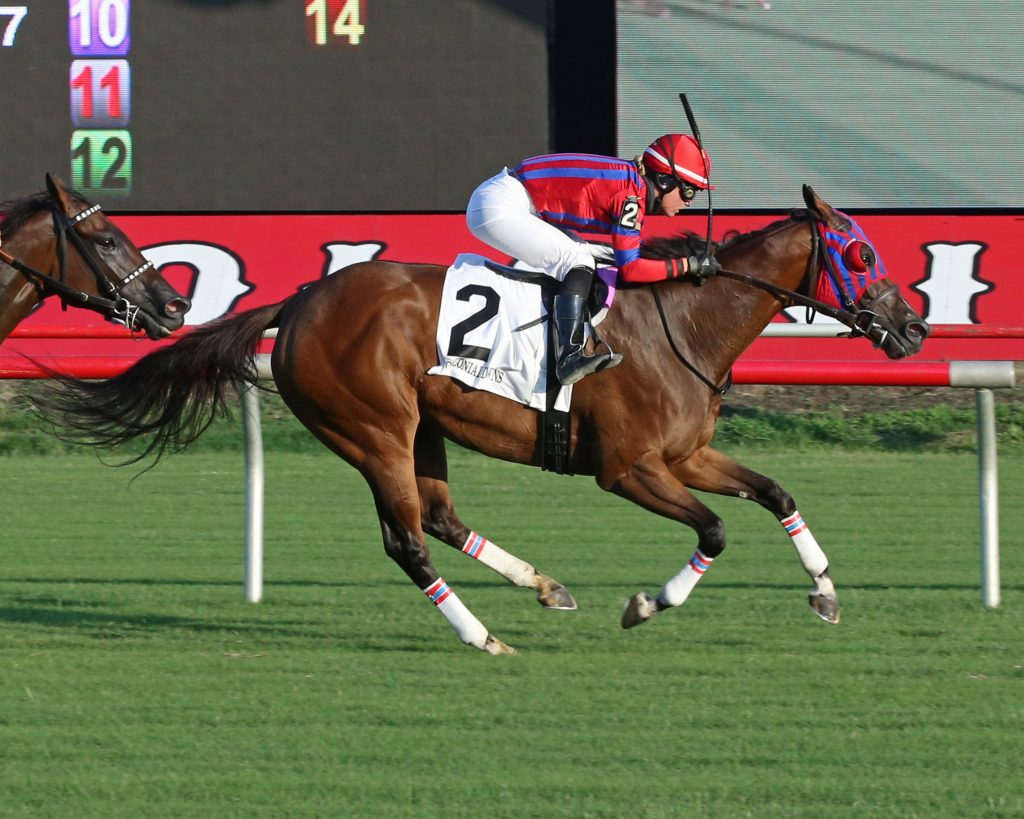
What the Beep won the M. Tyson Gilpin Stakes here last summer but hasn’t raced since an off-the-board finish in an allowance race at Laurel last October.
“She got a little cut on her leg and we almost missed that last race,” Godsey explained. “So she came home and got to spend the whole winter being a horse, hanging out, and ran around an 80-acre field with all her brothers. It’s nice she gets to do that, come back here and run like this. It’s kind of what her momma did. I would take her home every winter and come back here and win every summer. She’s a happy horse.”
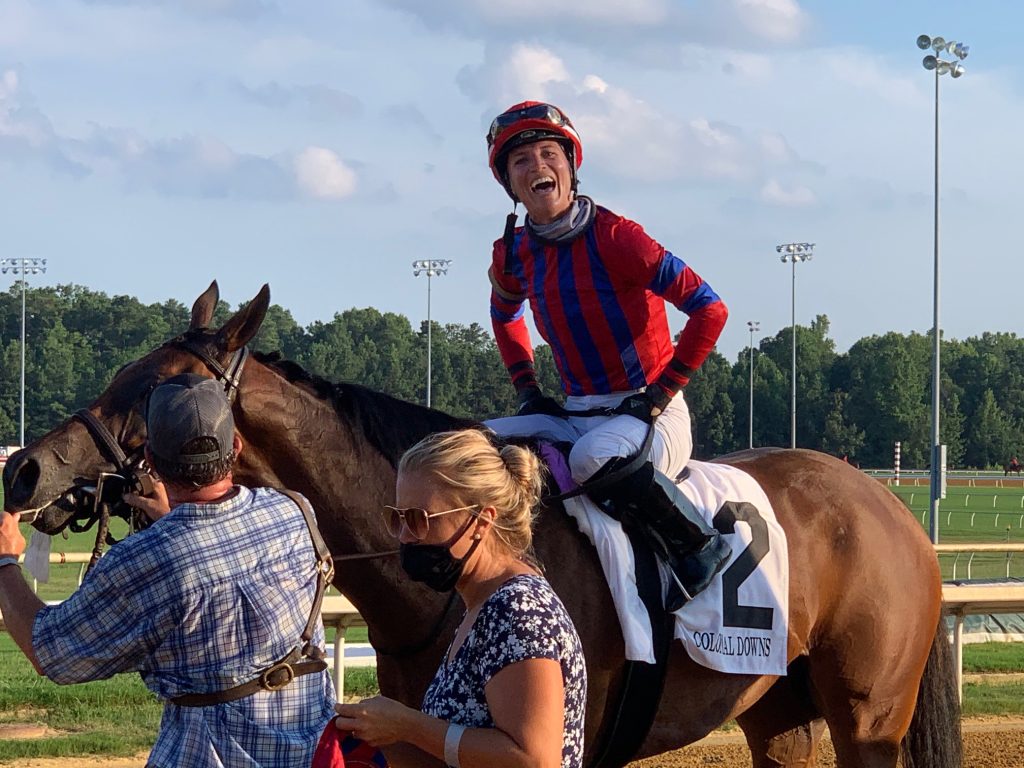
The Camptown was the fourth victory in 16 starts for What the Beep who could race next to defend her title in the M Tyson Gilpin Stakes. She earned $36,000 for the tally to boost her bankroll to $189,503 and paid $15.20, $4 and $2.20.
Tan and Tight, the 2-5 post-time favorite, stalked the pace and made a mild rally in the stretch but was no threat to the winner returning $2.20 and $2.20. Bella Aurora ($2.20) finished third in the six-horse field, followed by Solarte, Determined Love and Chasing Midnight to complete the order of finish.
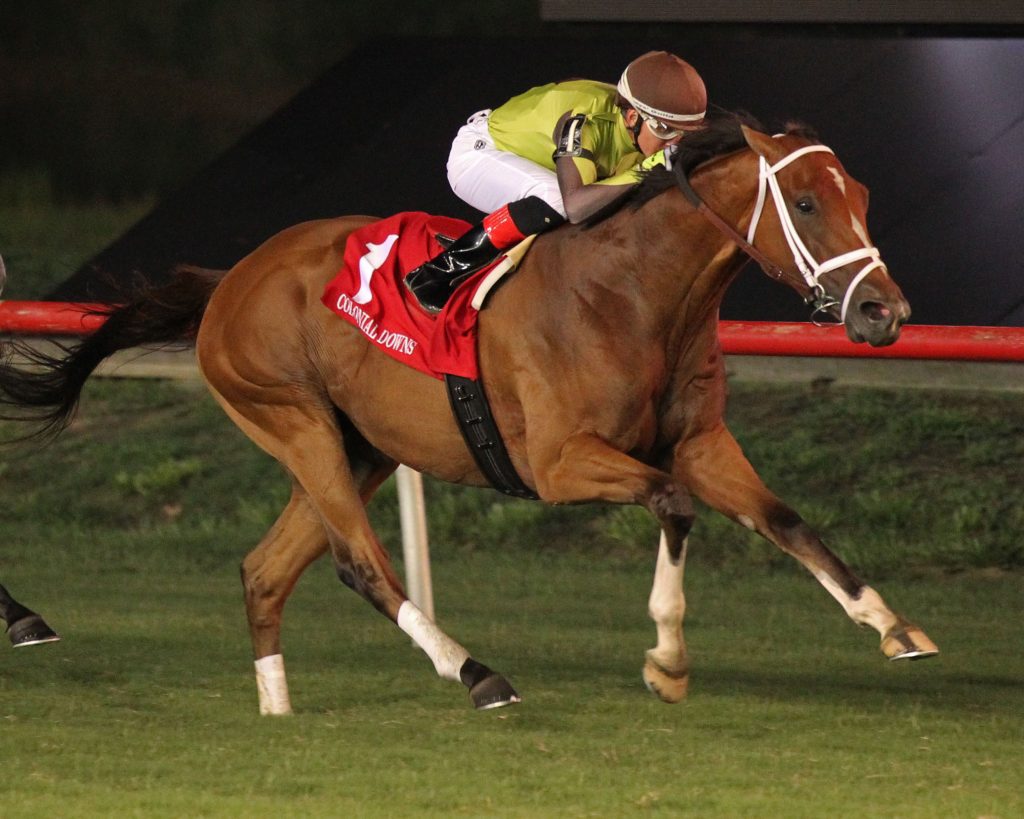
“I wanted to be a little closer than I was (early in the race),” Conner said. “I let him settle where he’s happy. My man Trevor (jockey McCarthy) had me in a little tight. I didn’t want to take back and go around. So I just went with the momentum and hoping he’s split somewhere and I could get through.”
Largent’s tally was his fourth in six starts and the $36,000 winner’s share boosted his bankroll to $134,670. He paid $2.40 and $2.10. There was no show wagering in the race.
Embolden, the 2019 Jamestown winner, was beaten just a length in the mile race and paid $2.10. Carbon Data and River Deep completed the order of finish.
Also of note on the card was the 3rd race, a first-level allowance race won by Robert LaPenta, Eclipse Thoroughbred Partners and Chrysalis Stable’s Farmington Road, who was making his turf debut after racing on the Triple Crown trail earlier this year. Pletcher and Conner partnered here as well with the son of Quality Road who had last raced in the Grade 1 Belmont Stakes, finishing eighth in a 10-horse field.
Scenes from Opening Night 2020 at Colonial Downs
Here is a series of photos from opening night festivities at Colonial Downs from Tuesday July 28. The “spectator-free” meet was delayed by one day when Monday’s originally scheduled card was postponed due to extreme heat advisories. Photos supplied by Coady Photography and the Virginia Equine Alliance.
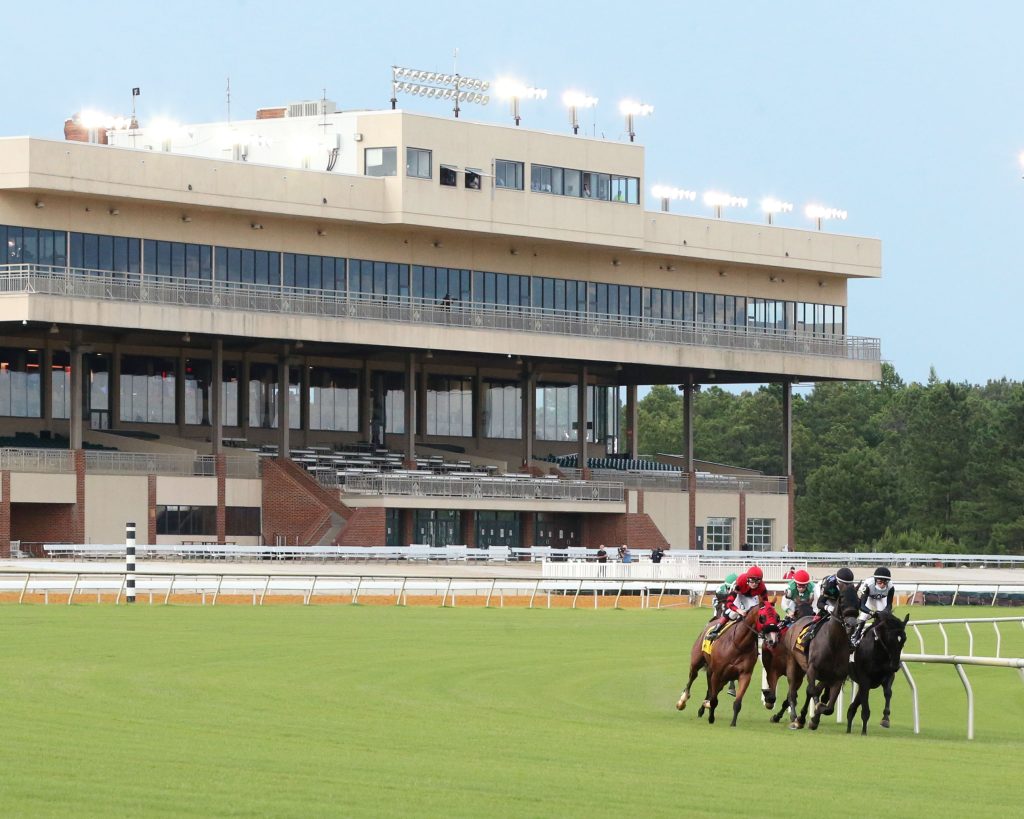
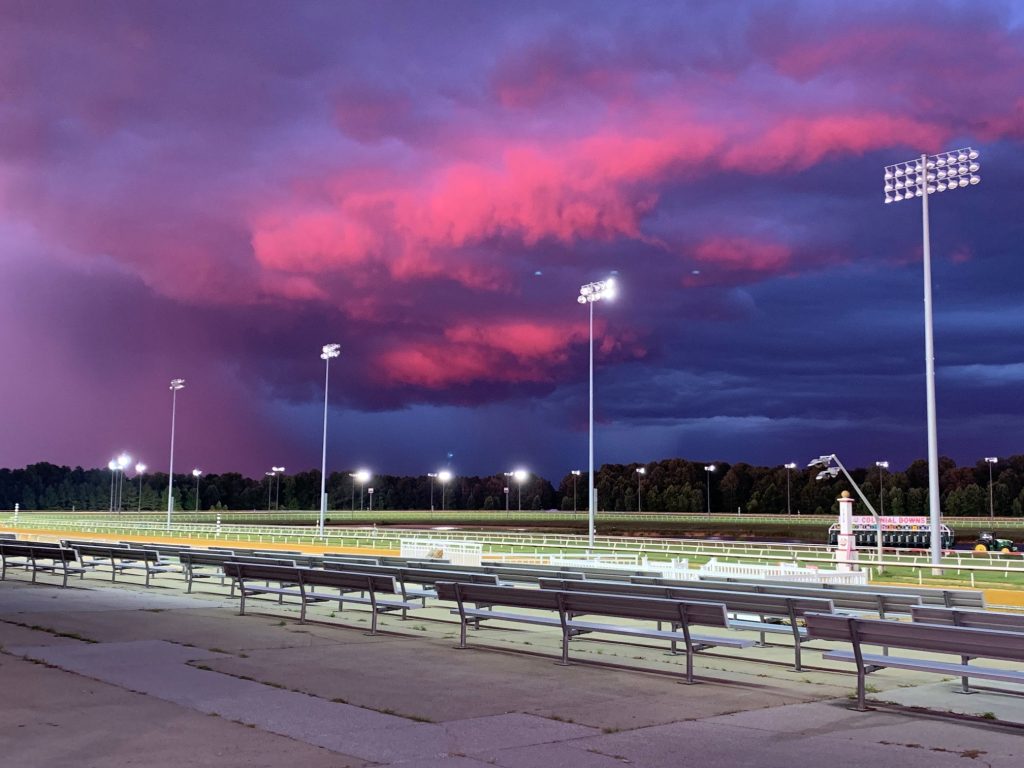
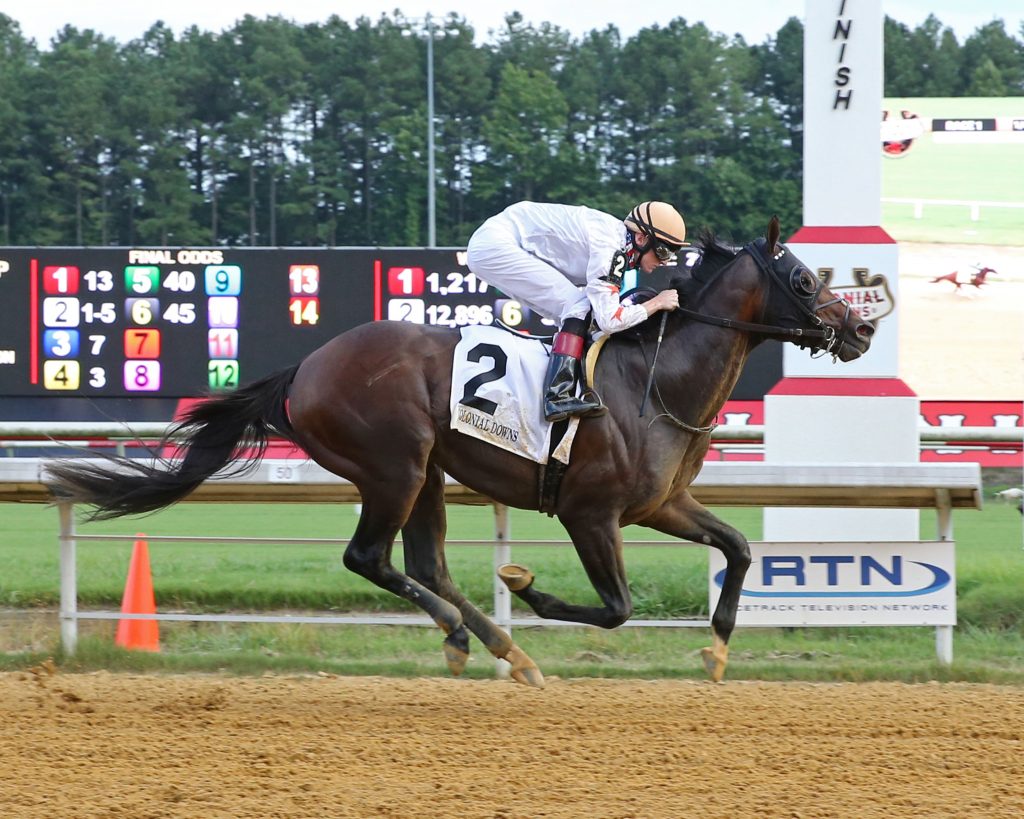
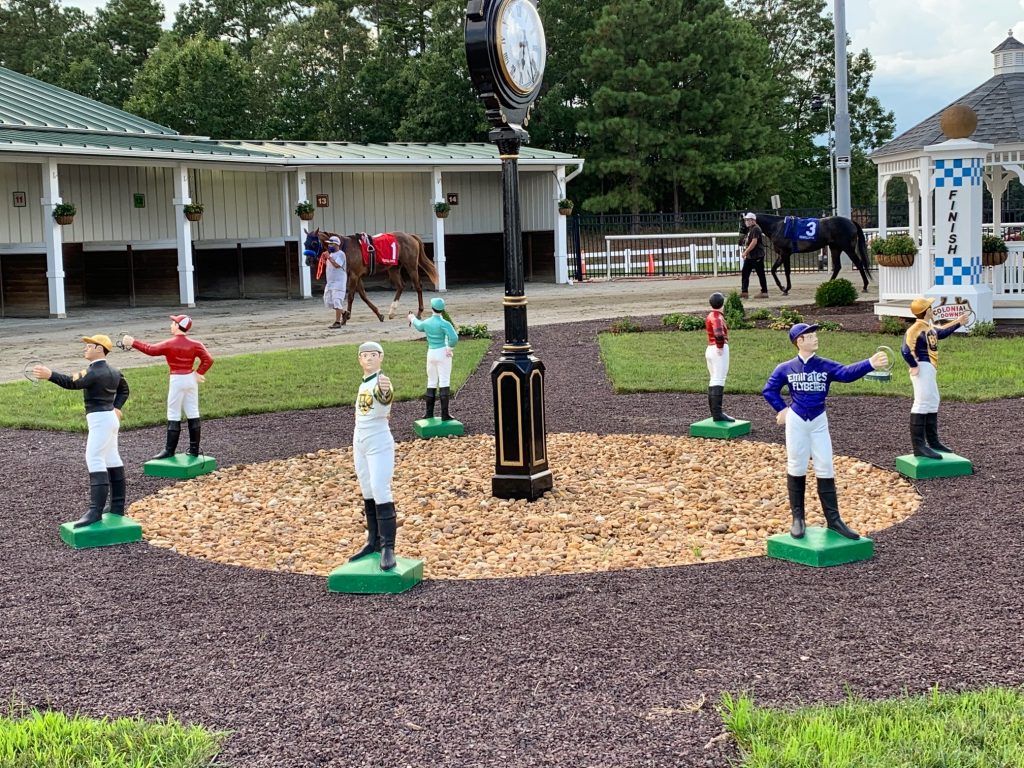
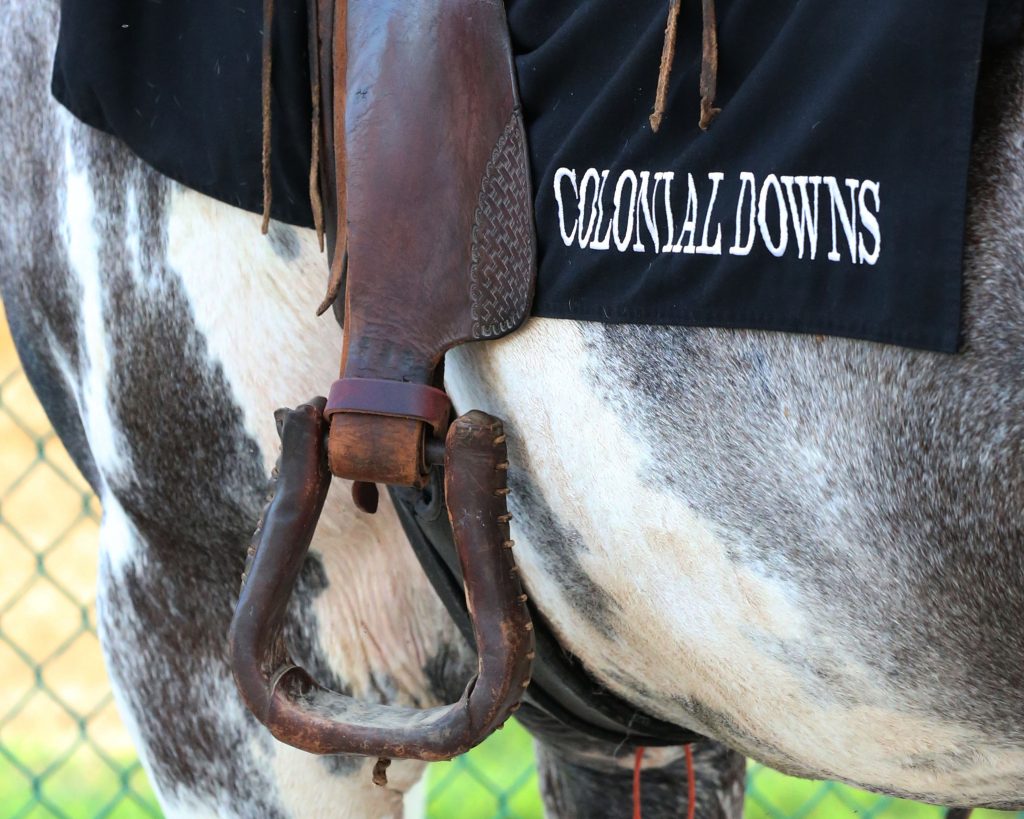
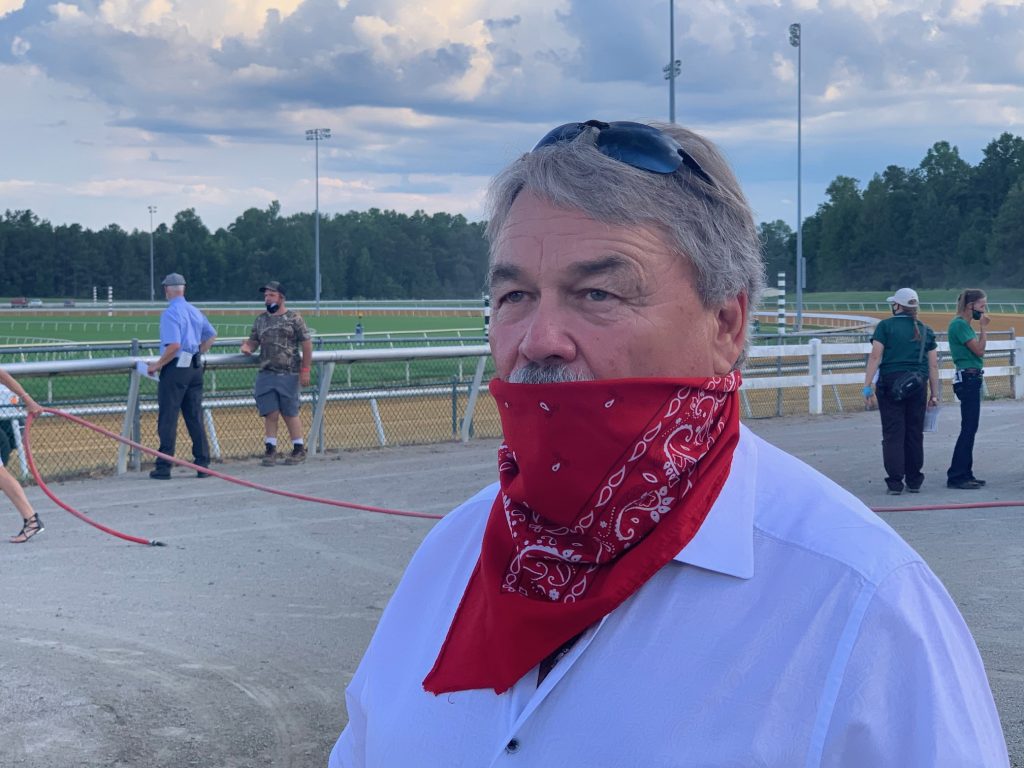
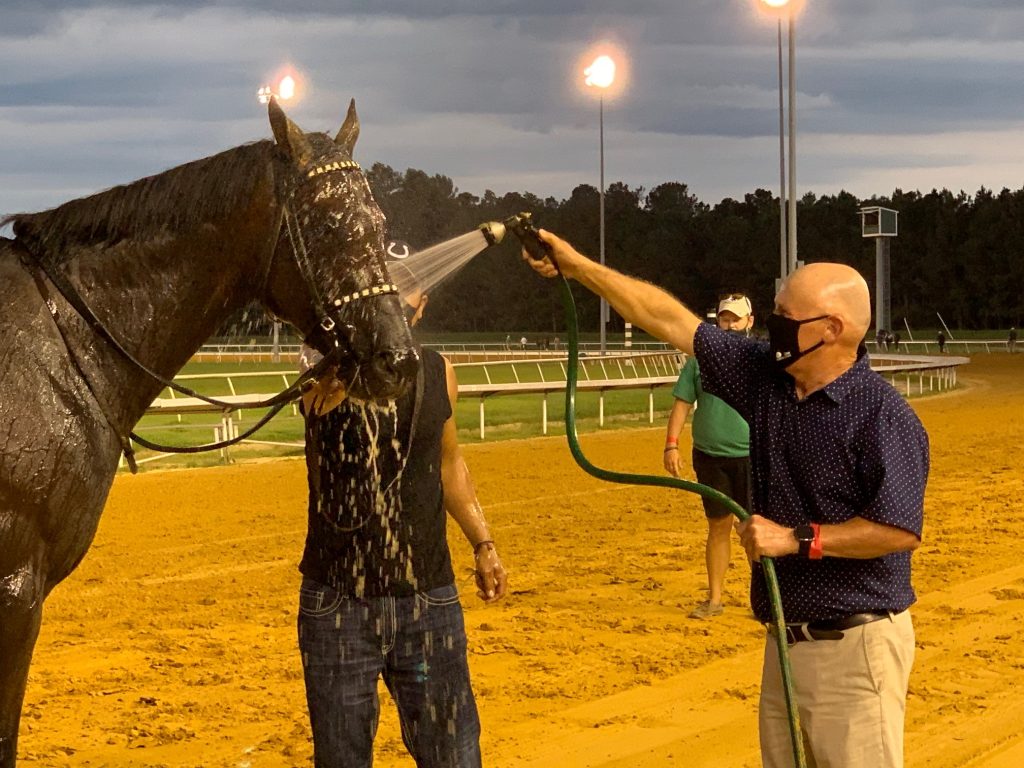
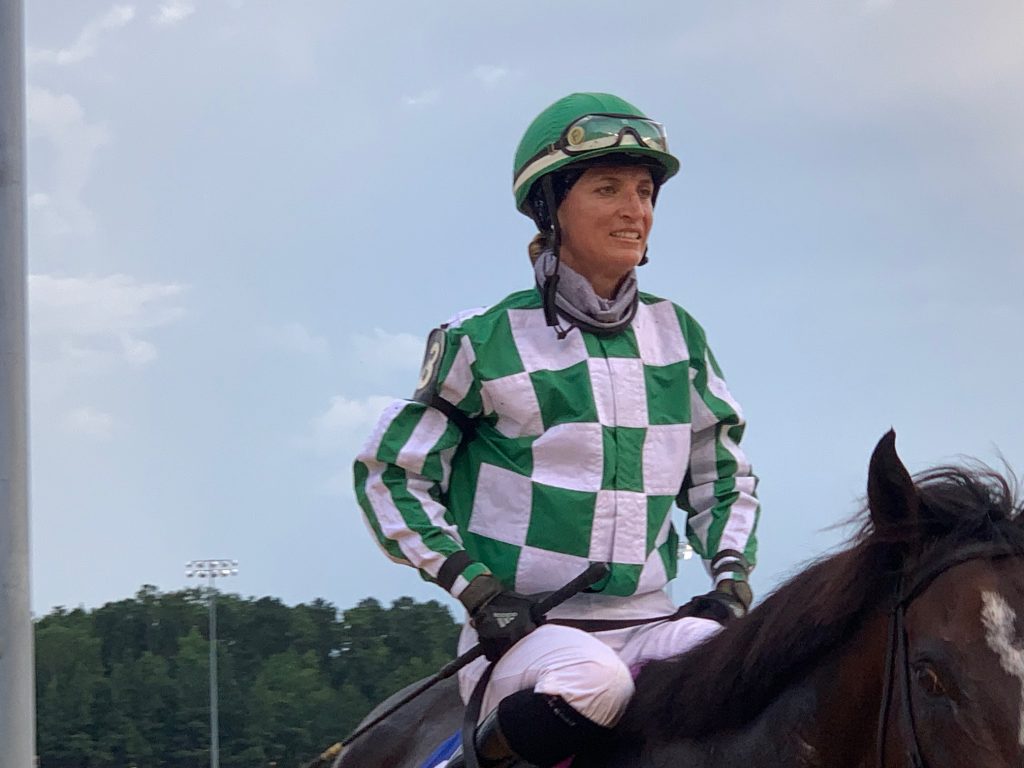
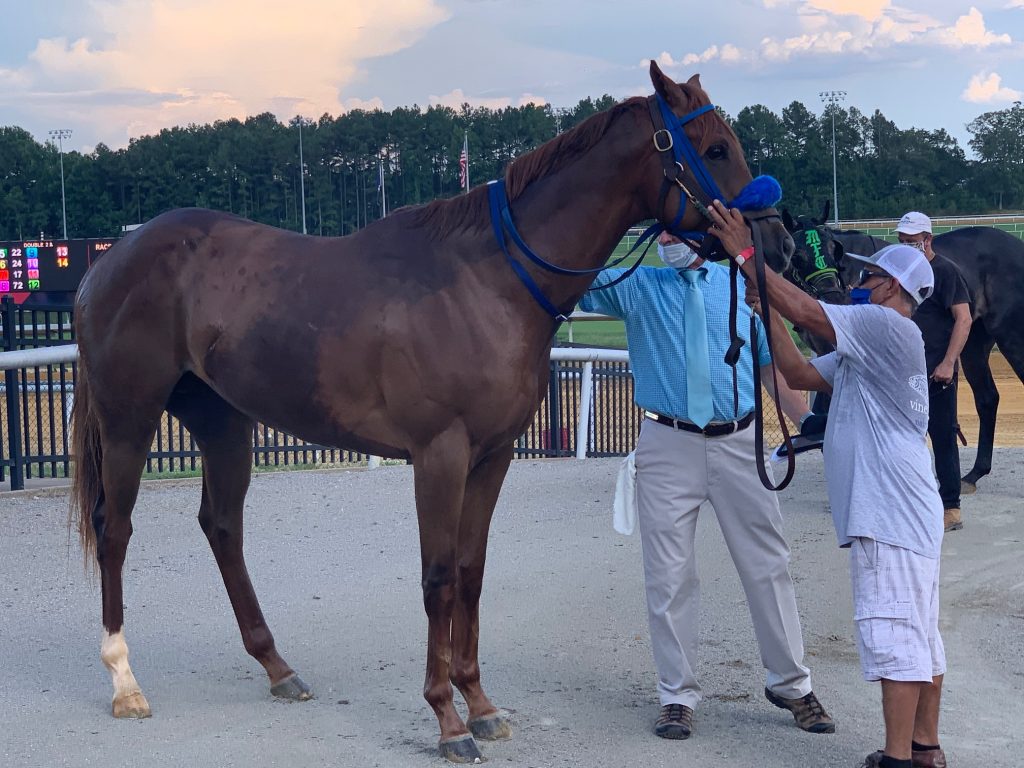

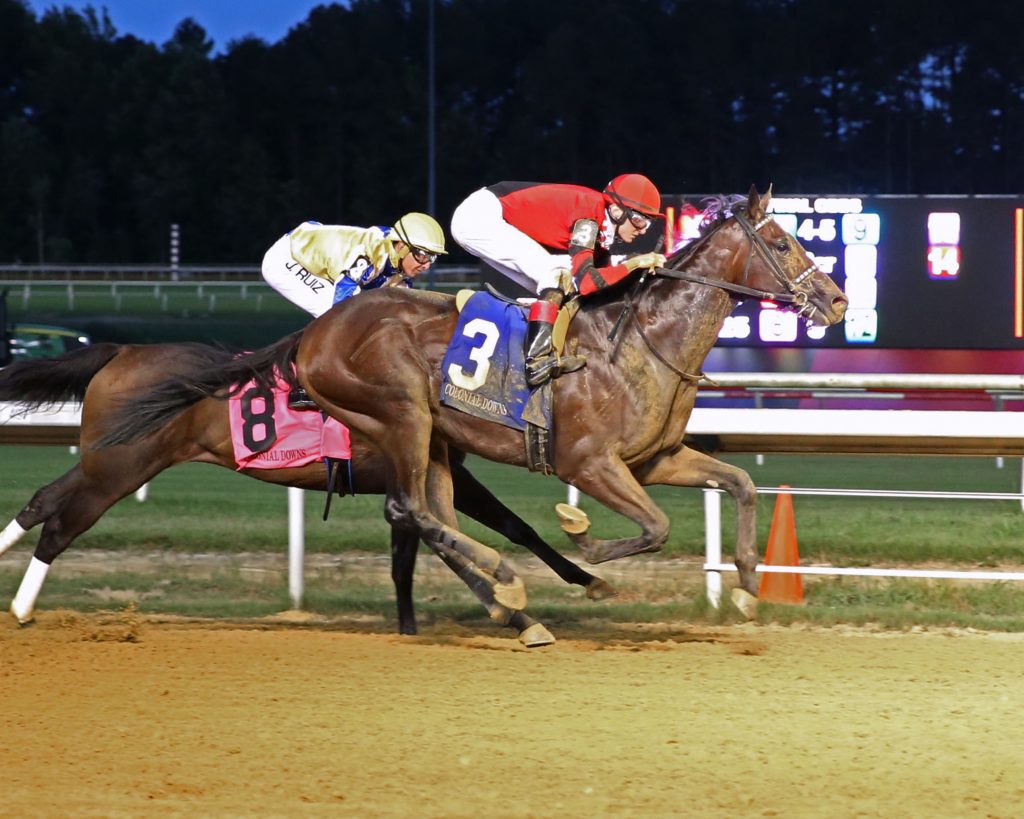
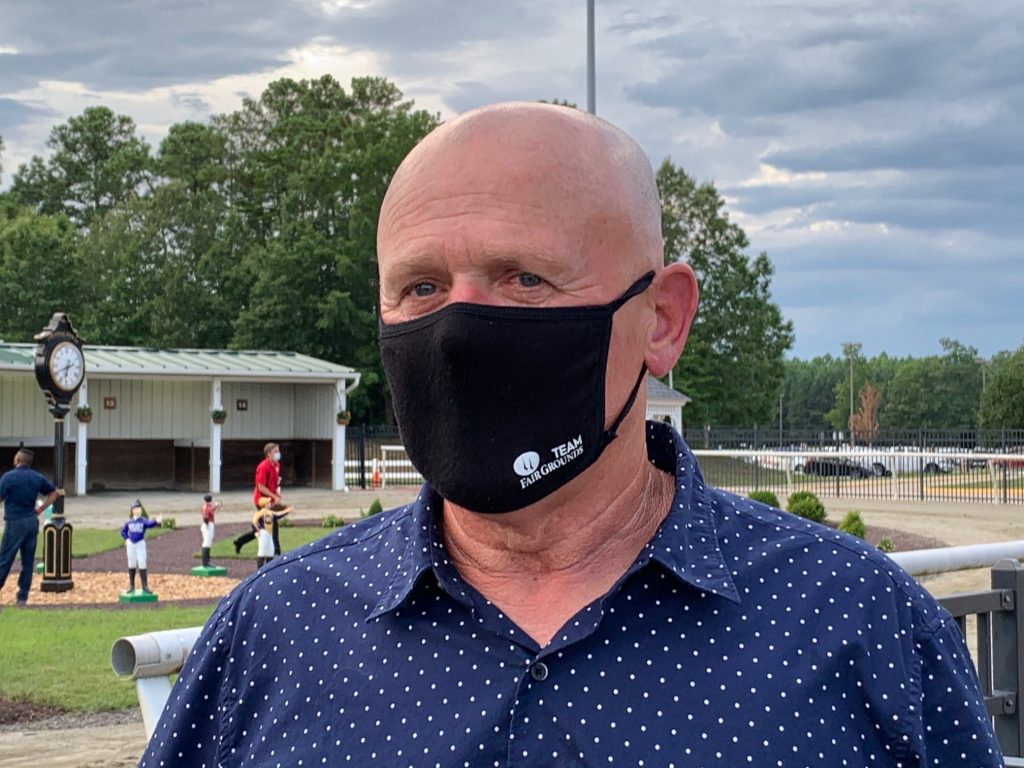
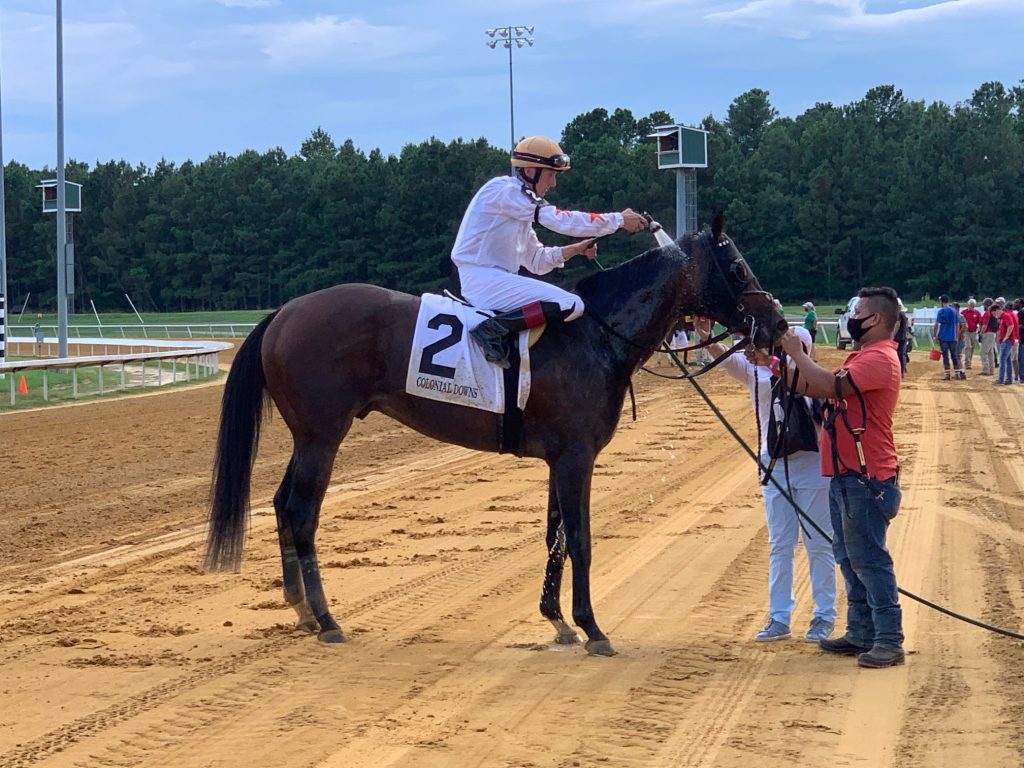
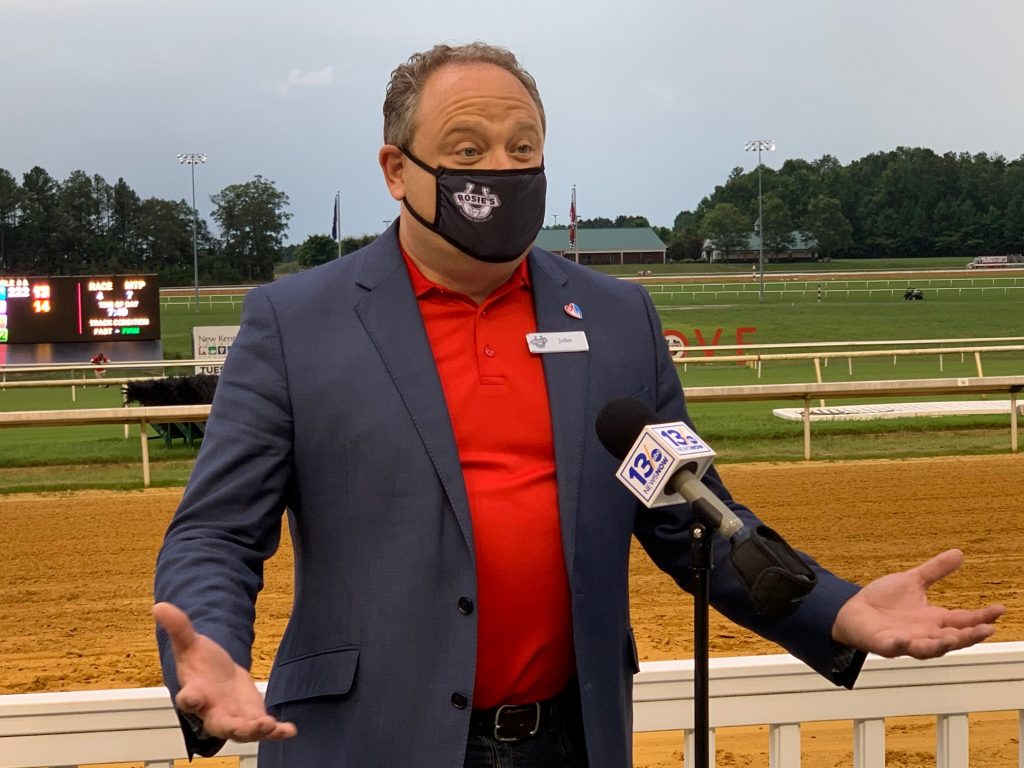
Guillaume Wins First Start In Virginia-Certified $40,000 Hansel Stakes at Colonial Downs
Guillaume rallied on the outside and overtook Merchant of Hope in the final strides of the $40,000 Hansel Stakes for Virginia Certified 2-year-olds on the Tuesday night opening night card at Colonial Downs. The son of Hard Spun is owned by DARRS Inc., trained by Mike Stidham and was ridden by Trevor McCarthy, the same owner-trainer-jockey combination who were leaders at the 2019 Colonial meeting.
The victory was third of four on the night for McCarthy and second for Stidham. “When we saw that his race was for Virginia-certified horses, it got on our radar,” said Stidham. “He was impressive at this distance but we’ll be looking to go longer in his next start.”
Named after a famous Canadian ballet dancer, Guillaume’s performance impressed owner David Ross. “Mike did a great job getting the horse ready and Trevor did a phenomenal job getting out in the lane and just getting him to the wire in time. The horse was moving forwardly at the finish. He’s an exciting horse to watch.”
Guillaume was making his career debut in the Hansel and banked $24,000 for the half-length victory. He covered the 5 ½ furlongs over a fast track in 1:04.38 and paid $6.40, $3.40 and $2.10. The winner was broken at the Middleburg Training Center by Ballyerin Racing’s Madison Meyers and Kieran Norris. The Center recently underwent a multi-million-dollar upgrade.
Merchant of Hope set the pace in the five-horse field through fractions of 22.85 seconds for the opening quarter, 46.11 seconds for a half-mile and a five-furlong split of 58.06 seconds. The son of Bayern paid $4.00 and $2.40.
It was another 1 ¾ lengths back to third-place finisher and post-time favorite Sky’s Not Falling who returned $2.10 to show. Natural Attraction and Dare to Promise completed the order of finish.
Earlier in the card, Wesley Ward’s Amsden went gate-to-wire in a $40,000 five-furlong maiden turf race for two-year-olds. The American Pharoah colt won by three lengths. Last year, Ward connected in a Colonial turf sprint with another two-year-old, Four Wheel Drive, who captured the Rosie’s Stakes and went on to win the Breeders’ Cup Juvenile Turf Sprint.
Colonial Downs’ summer meeting continues racing through September 2 on a Monday through Wednesday basis with a first post of 5:30 EDT. A special Sunday program has been added August 2 to make up for the cancellation of Monday’s scheduled card.
Colonial Downs Post Time For Tuesday’s Opening Day Card Pushed Back One Hour to 6:30 PM
UPDATE AS OF TUESDAY 7/28 AT 9 AM — Post time for Tuesday’s opening day card is now 6:30 instead of 5:30 PM. Safety First as Due to Heat Conditions
(NEW KENT, Va.) – July 27, 2020 – In an abundance of caution, Colonial Downs Group is postponing today’s opening card at the Colonial Downs racetrack in New Kent County. With heat index forecasts over 100 degrees, the change is to safeguard the health of people working, transportation of horses and horses racing during these conditions. Monday’s races will be re-scheduled for Sunday, August 2.
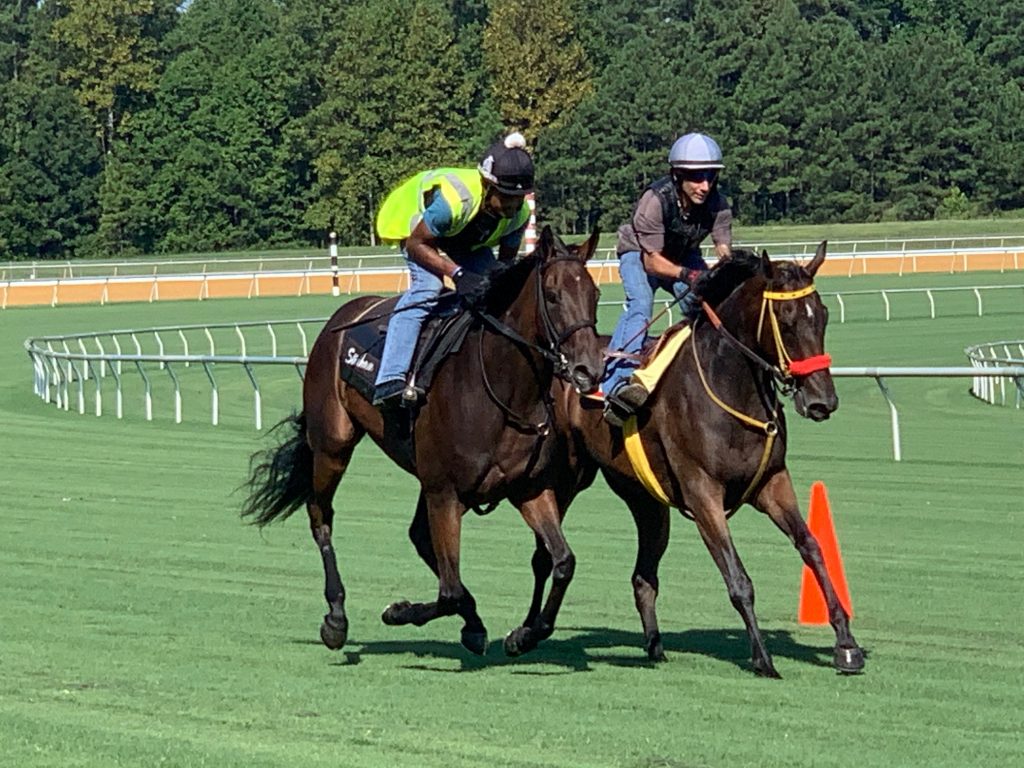
The opening day program now becomes Tuesday July 28 now with nine races scheduled and a first post of 5:30 PM.
Colonial Downs Group, a subsidiary of Peninsula Pacific Entertainment, announced last week that it will alter course from hosting limited spectators to a “spectator-free” racing program for the 2020 race meet. The change to “spectator free” racing enables Colonial Downs to focus extra care towards key operating areas, such as the jockeys’ quarters, paddock supervision, racing office and the stabling area during COVID-19. Under spectator-free designation, fans are encouraged to tune into the TVG Network to watch live racing from Colonial Downs and wager via tvg.com; twinspires.com; expressbet.com and nyrabets.com.
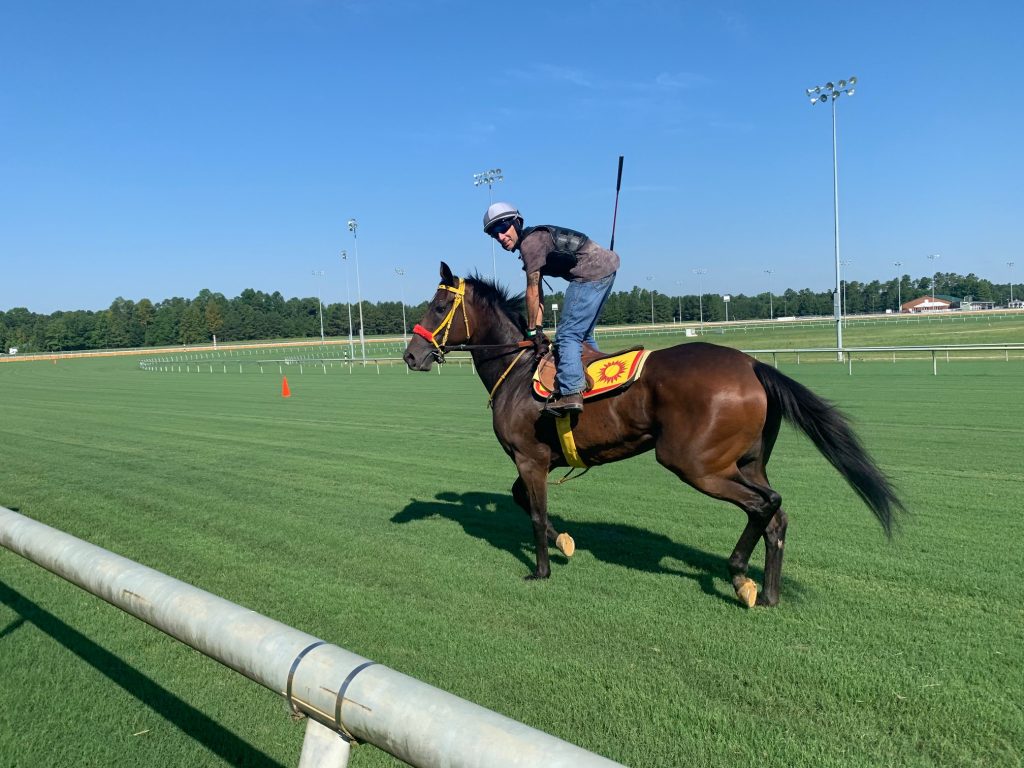
Horses got a chance to exercise on Colonial’s Secretariat Turf Course in advance of Tuesday’s rescheduled opening card.
About Colonial Downs: In its first partial year of operations, Colonial Downs Group opened four locations, created more than 1,000 jobs, and contributed more than $14.4 Million in taxes and racing industry payments in Virginia. At Rosie’s Gaming Emporiums in Richmond, Hampton, New Kent, and Vinton we offer innovative historic horseracing (HHR) gaming technology and full card simulcasting. At Colonial Downs Racetrack in New Kent County, we offer live thoroughbred racing at the best turf track in the country and will run 18 days in 2020.
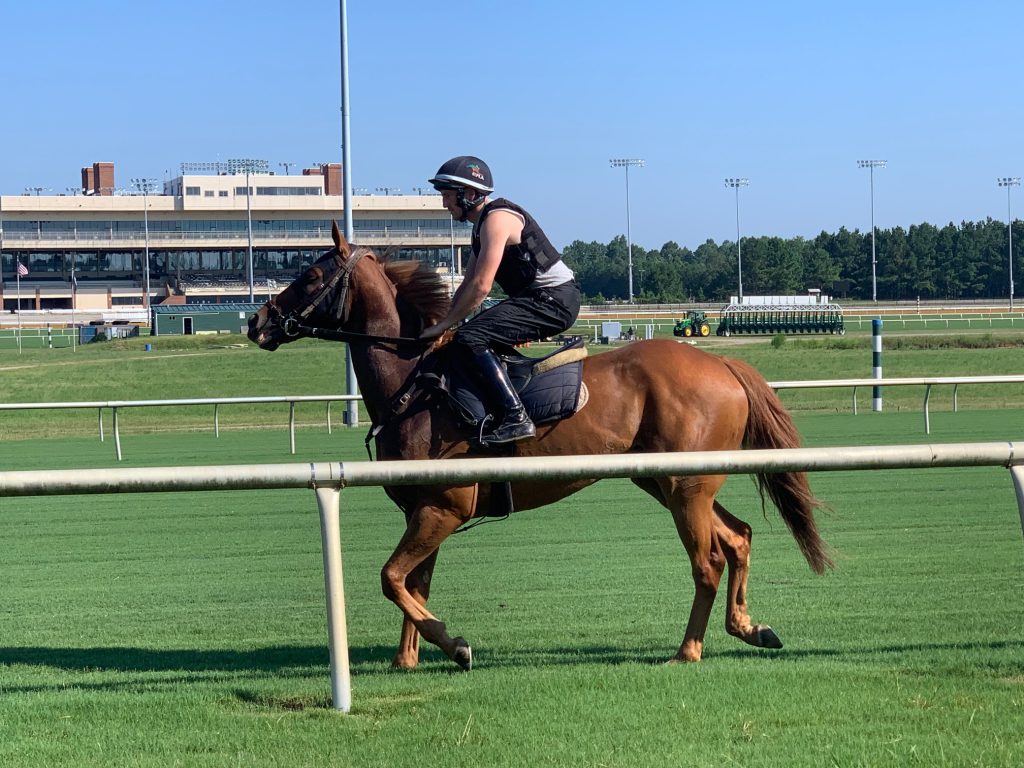
Colonial Downs Group has made a $300 million investment in the Commonwealth of Virginia. According to a recent study, the company’s operations were poised to generate $26.1 million in state tax revenue, $17.9 million in local tax revenue, and $445 million in overall economic activity in Virginia in the year 2020, along with contributing $25 million annually to Virginia’s horse industry in future years. The Colonial Downs Group looks forward to reopening fully and achieving those goals moving forward.
Wednesday’s Virginia-Bred/Sired Stakes Races at Colonial Feature 2019 Evans, Jamestown & Gilpin Stakes Winners
River Deep, winner of the 2019 Edward P. Evans Stakes, will try to defend his title Wednesday (July 29) at Colonial Downs against six other Virginia-bred/sired horses including Todd Pletcher trainee Largent and 2019 Jamestown Stakes winner Embolden. The $60,000 one-mile turf stakes has been carded as the eighth race.
Morgan Ford Farms’ River Deep won last year’s Evans courtesy of a disqualification when initial first place finisher Speed Gracer was tagged for interference and placed fourth. Forest Boyce will ride the Phil Schoenthal trainee who enters with a bankroll of $298,130. The 6-year-old Arch gelding has a won pair of other Virginia-bred stakes — the Bert Allen and Hansel, both in 2018.
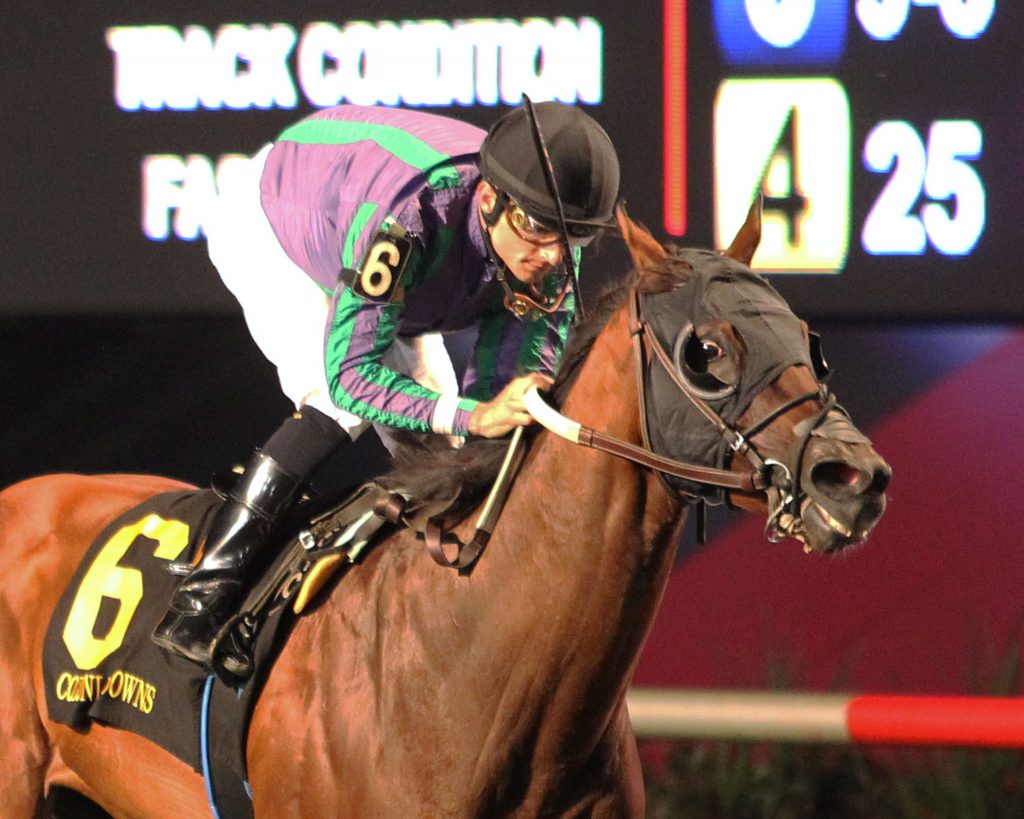
Dare To Dream Stables’ Embolden has earned “top-three” finishes in all six of his starts. The 3-year-old The Factor colt will make his 2020 debut Wednesday. He finished 2019 with a third in Remington’s Springboard MiIe and preceded that with runner-ups in the Atlantic Beach Stakes and Grade 3 Futurity Stakes at Aqueduct and Belmont respectively. Trevor McCarthy, Colonial’s leading rider last year, has the mount for trainer Michael Stidham. Embolden was bred by Nancy Terhune and Ernest Frohboese.
Twin Creeks Racing and Eclipse Thoroughbred Partners’ Largent brings an impressive resume into the stakes. The 4-year-old Into Mischief gelding is fresh off an allowance optional claiming win March 28 at Gulfstream. In five starts, he has three wins and two seconds with earnings of $98,670. Largent is 3-for-3 on turf. He was bred by Lazy Lane Farms.
Other entrants include Black Prong — who was third in the Evans last year — along with Fionnbharr, Carbon Data and Ismusbemyluckyday.
Six Virginia-bred/sired horses will compete in the $60,000 Camptown Stakes including 2019 M. Tyson Gilpin Stakes winner What the Beep, Jamestown Stakes runner-up Bella Aurora and New York/New Jersey invader Tan and Tight. The 5 1/2-furlong turf test for fillies and mares three and up is the fourth race on the card.
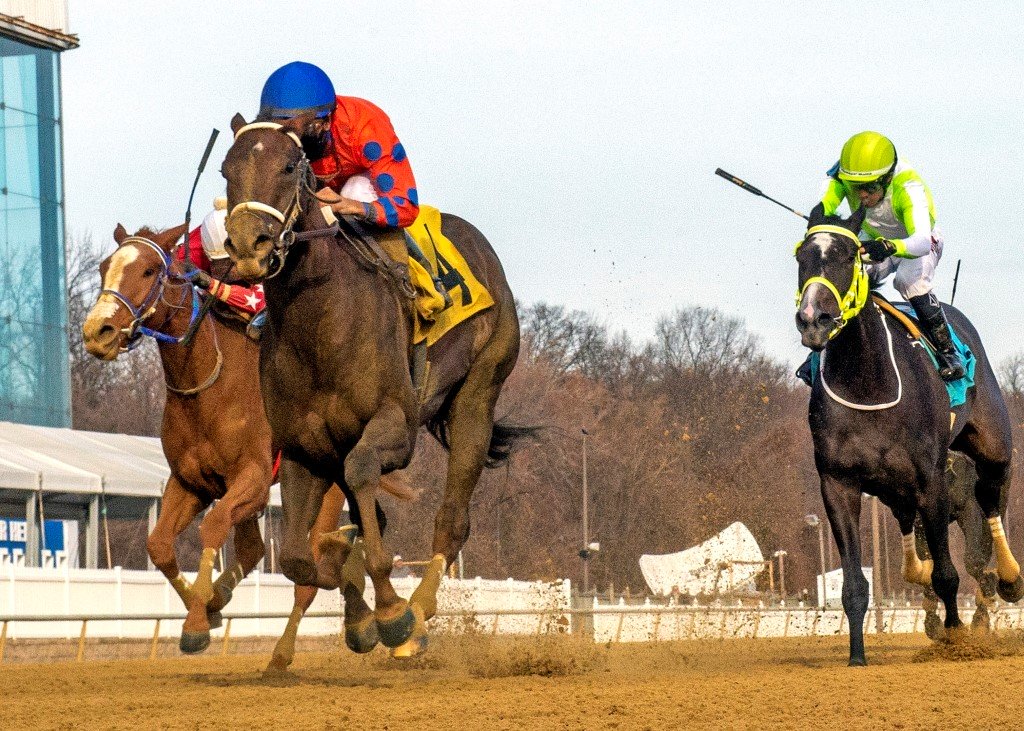
Eagle Point Farm’s What the Beep enters 2020 action with a bankroll of $153,503. Jockey Forest Boyce, who directed the winning Gilpin effort last year, will be up again. Trainer Karen Godsey’s home bred — a 5-year-old Great Notion mare — finished fourth in last year’s Camptown. What The Beep is 3-for-7 on turf.
Country Life Farms’ Bella Aurora is the highest money earner in the field with $154,140. The 3-year-old Carpe Diem filly capped off 2019 with a win in Laurel’s Gin Talking Stakes. Bred by Morgan’s Ford Farm and trained by Mike Trombetta, Bella Aurora will be ridden by Keiber Coa.
e Five Racing Thoroughbreds’ Tan and Tight is trained by Michael Stidham and gets the services of jockey McCarthy. The 4-year-old Uncle Mo filly powered home in a maiden special weight January 19 at Aqueduct over a sloppy dirt track. She returned to turf in her only start since — a tight runner-up at Monmouth July 5. Overall, she has finished second in all three of her career turf outs. Tan and Tight was bred by Jim and Katie Fitzgerald.
Rounding out the field is Solarte — Camptown runner-up in 2019 — along with Determined Love and Chasing Midnight.
Tuesday’s (July 28) $40,000 Hansel Stakes, open to Virginia-bred, sired and certified two-year-old horses, will be contested at 5 1/2 dirt furlongs as the fourth race. Only three of the eight horses entered have made a start and each won their maiden special weight debuts — Natural Attraction, Merchant of Hope and Sky’s Not Falling, an early 9-5 favorite. The latter was bred in Maryland by Larry Johnson and won his five-furlong bow at Delaware July 1. The Seville gelding is trained by Trombetta and will be ridden by Coa.
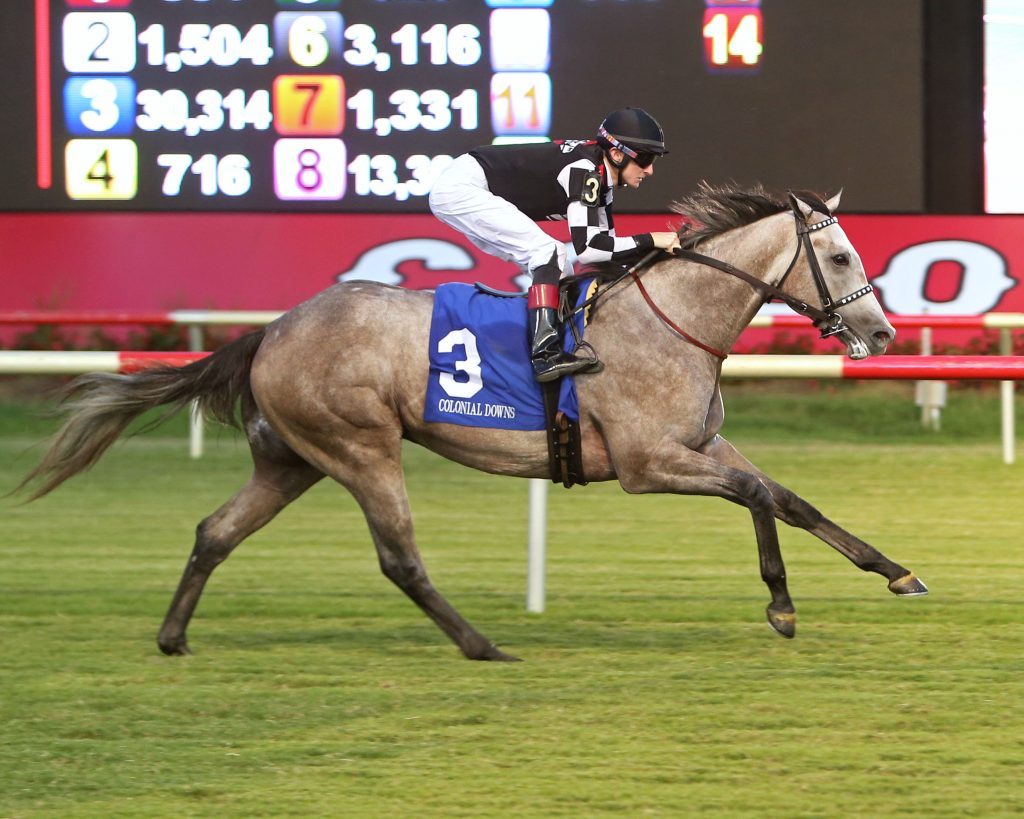
Second early choice is David Ross’s Guillaume, who is a Kentucky-bred colt by Hard Spun. Trevor McCarthy will ride for trainer Stidham. Ross, whose stable name is DARRS, Inc., was leading owner at Colonial last year with five victories.
Others entered include a pair of Susan Cooney-trained Virginia-breds — Stay In and Canherun. Dare to Promise and Alpha Queue round out the field.
Colonial’s season continues through September 2 with cards every Monday, Tuesday and Wednesday at 5:30 PM. A makeup card for Monday’s (July 27) heat-related cancellation will be held on Sunday August 2 at the same time. The track will feature a nightly All-Turf Pick-5 wager that covers the program’s final five races.
The 2020 race meet will be presented “spectator-free”. In Virginia, bets can be placed at any Rosie’s Gaming Emporium or at any VA-Horseplay Off Track Betting location. Online betting is available through TVG.com, Xpressbet.com, Twinspires.com and NYRABets.com. All of Colonial’s races will be aired on TVG. More details are at colonialdowns.com/wagering.
Colonial Meet Preview; Opening Day Card Cancelled; Make Up Day on Sunday Aug. 2; Entries Taken Tues. July 27
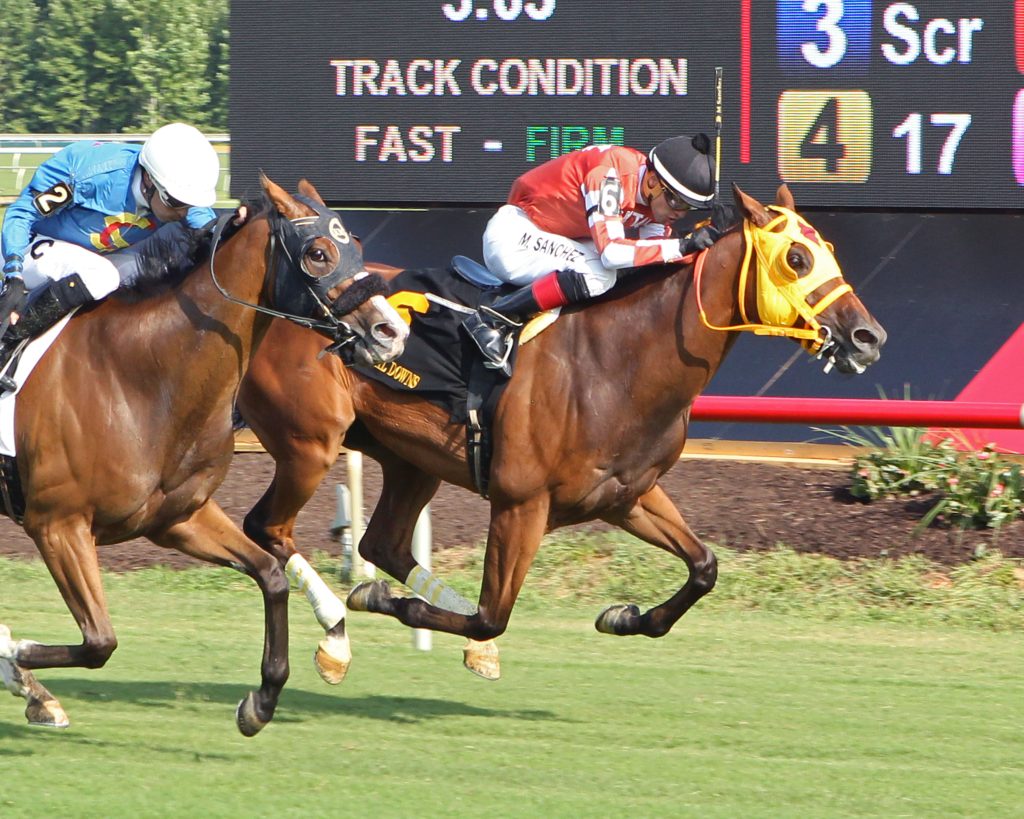
The featured race is a $42,000 turf allowance for 2-year-olds at 5½ furlongs. A field of nine will battle in the eighth race including seven last-time-out winners. The only two that did not prevail most recently were Sunshine City and Crown and Coke, who raced in stakes at Royal Ascot and Churchill Downs, respectively.
A jockey colony of some 30 riders will be based in New Kent for the six-week meet including Trevor McCarthy, last year’s top jock with 15 wins. Through July 22 this year, McCarthy is ranked 30th in the country by purse earnings with $2,576,300. Daniel Centeno, who tied for second with 13 victories, is back as is Forest Boyce, who finished fourth in the standings. The trio will be busy on opening night. McCarthy and Boyce have nine mounts each while Centeno has eight.
Veteran jockeys Chuck Lopez and Alberto Delgado are part of the group. Lopez competed at Colonial in 2019 and collected seven wins. The 59-year-old has 4,301 wins from over 30,000 starts. Delgado will be riding for the first time since 2017. The 56-year-old, who has 2,932 victories from over 25,000 starts, rode California Chrome to his first two wins in 2013. Lopez has six mounts Monday while Delgado has two.
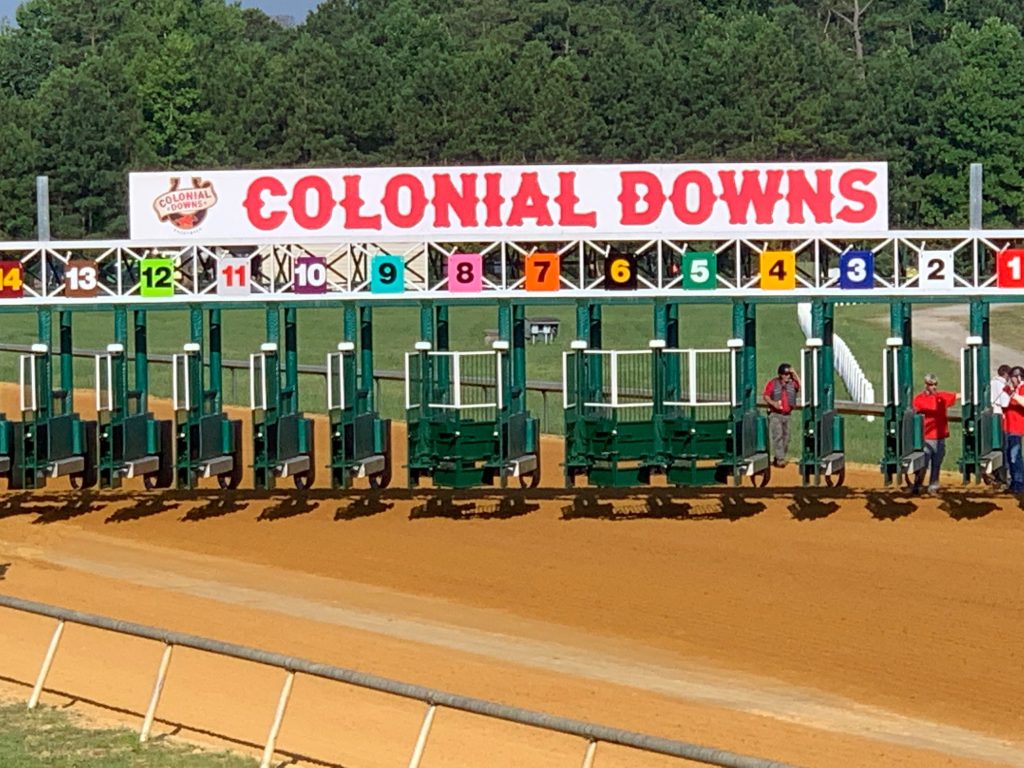
Mike Stidham and Jamie Ness, co-leading trainers at the 2019 meet with 10 wins each, have horses entered Monday. The former, who won the 2019 Virginia Oaks with Carnival Colors and Kitten’s Joy with Doc Boy last summer, has Princess Grace in the seventh and Palio in the fifth. The latter sends Hazels Little Man out in the featured eighth.
Also supporting the opener are Graham Motion, whose English Bee captured the 2019 New Kent County Virginia Derby (G3), and Wesley Ward, whose Four Wheel Drive won the Exacta Systems Rosie’s Stakes then went on the win the Breeders’ Cup Juvenile Turf Sprint (G1). Motion’s’ Dance Recital appears in the seventh and Ward’s Sunshine City competes in the feature. Both Ferris Allen, Colonial’s all-time leading conditioner, and King Leatherbury, fifth leading all-time trainer nationally with 6,503 victories, have a pair entered.
The track will feature a nightly All-Turf Pick-5 wager that covers the program’s final five races. Colonial is in a unique position because its track lights illuminate the grass course instead of the dirt oval. Three of the five legs in Monday’s wager have either a 13- or 14-horse field.
The early steeplechase races will be a staple of every Monday card this summer. Opening day’s pair feature 10-horse fields and seven in each raced most recently in Virginia — either at the Middleburg Spring Races or the Virginia Gold Cup at Great Meadow which both took place in June.

The 2020 race meet will be presented “spectator-free” out of an abundance of caution so Colonial Downs’ personnel can focus extra care towards key operating areas, such as the jockeys’ quarters, paddock supervision, racing office and the stabling area.
The season continues through September 2 with cards every Monday, Tuesday and Wednesday at 5:30 PM. The Grade 3 Virginia Derby highlights the meet and will be contested on Tuesday September 1 along with other five stakes.
In Virginia, wagering on Colonial Downs races can be placed at any Rosie’s Gaming Emporium or at any VA-Horseplay Off Track Betting location. Online betting is available through TVG.com, Xpressbet.com, Twinspires.com and NYRABets.com. All of Colonial’s races will be aired on TVG. More details are at colonialdowns.com/wagering.


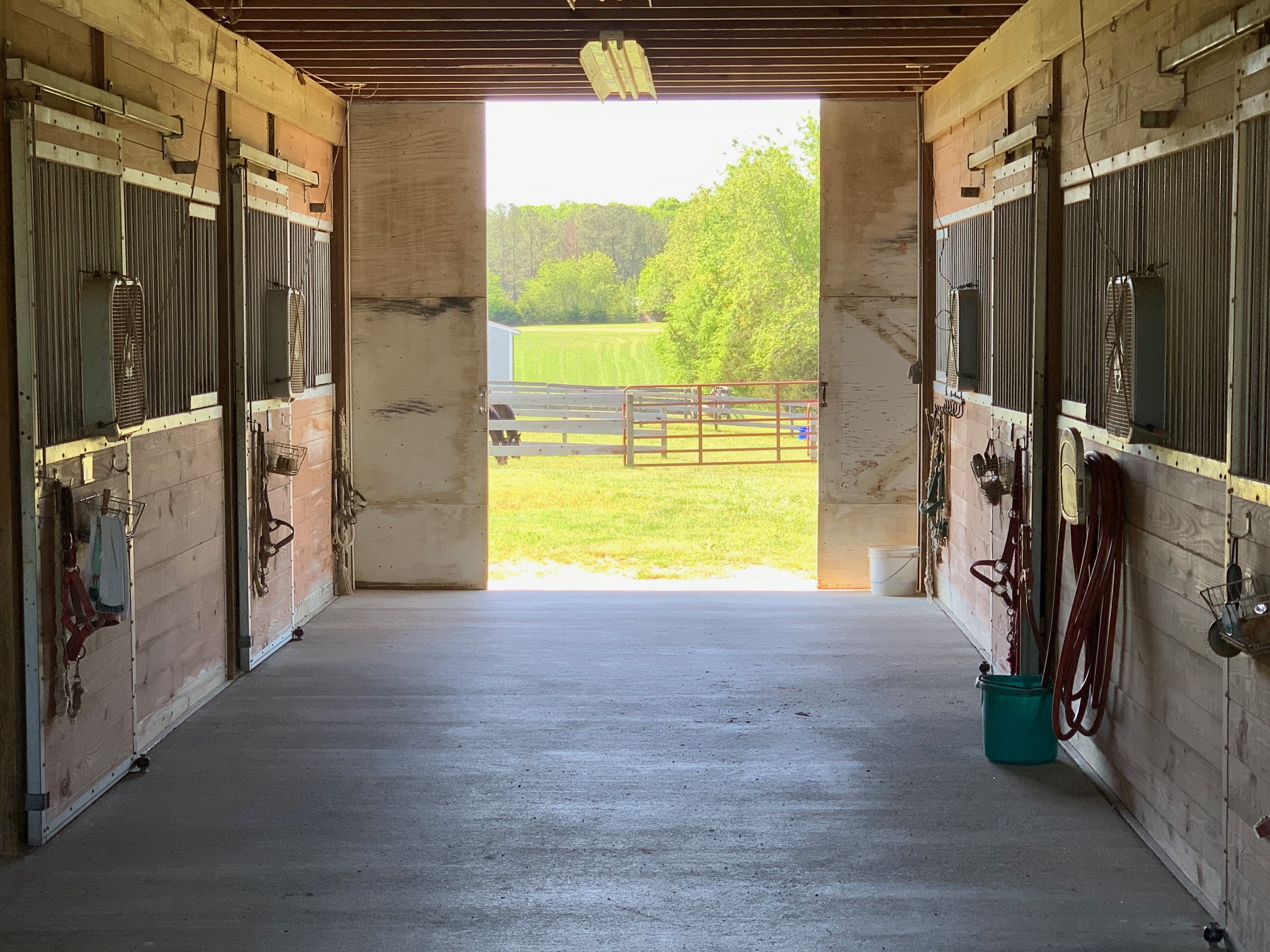
 Meet Jill Byrne Jill Howe Byrne was born at her family’s Red Horse Farm in Barboursville, Virginia. She was asked, but she declines to reveal her age. “A lady never tells her age, (but) I’m old enough to know better.” Byrne’s father Peter Howe was Marion du Pont Scott’s trainer at Montpelier, and Byrne remembers a “magical” childhood growing up at the estate. “My mom would pick my sister Debbie and I up from Grymes Memorial School in Orange, and we would go to Montpelier to have tea with Mrs Scott,” she recalls. “Mrs. Scott loved my mother; they were very close.” Tea parties were held in the Red Room, wall-to-wall win photos, awards and books on Thoroughbred racing and pedigrees. “We (kids) had to sit and be polite until we were given the clear to go, then we’d run through the halls of Montpelier as if it were our own. We’d be running up and down the stairs, up and down all the corridors where there’s millions of dollars’ worth of old paintings and old chairs James Madison had sat in, and of course we’re not thinking at the time.”
Meet Jill Byrne Jill Howe Byrne was born at her family’s Red Horse Farm in Barboursville, Virginia. She was asked, but she declines to reveal her age. “A lady never tells her age, (but) I’m old enough to know better.” Byrne’s father Peter Howe was Marion du Pont Scott’s trainer at Montpelier, and Byrne remembers a “magical” childhood growing up at the estate. “My mom would pick my sister Debbie and I up from Grymes Memorial School in Orange, and we would go to Montpelier to have tea with Mrs Scott,” she recalls. “Mrs. Scott loved my mother; they were very close.” Tea parties were held in the Red Room, wall-to-wall win photos, awards and books on Thoroughbred racing and pedigrees. “We (kids) had to sit and be polite until we were given the clear to go, then we’d run through the halls of Montpelier as if it were our own. We’d be running up and down the stairs, up and down all the corridors where there’s millions of dollars’ worth of old paintings and old chairs James Madison had sat in, and of course we’re not thinking at the time.” The field for the 1971 Noel Laing races in front of the house at Montpelier.©Douglas LeesNo surprise since her father had his start on show hunters and jumpers before launching his race-training career, Byrne started out riding pony hunters, training with legendary Virginia horseman Jimmy Lee. She says her show career was short-lived. “When my dad put me up on my first racehorse when I was 12, that was the end of that. No more show horses for me.” Byrne galloped for her father at the estate, schooling jumpers and working horses on the turf and on the sand training track. She continued to ride while at boarding school in New York near Scott’s private barn on the Belmont Park backstretch. The Masters School in Dobbs Ferry was 45 minutes to Belmont, Byrne says. “I’d go there on weekends and gallop horses for my dad.”
The field for the 1971 Noel Laing races in front of the house at Montpelier.©Douglas LeesNo surprise since her father had his start on show hunters and jumpers before launching his race-training career, Byrne started out riding pony hunters, training with legendary Virginia horseman Jimmy Lee. She says her show career was short-lived. “When my dad put me up on my first racehorse when I was 12, that was the end of that. No more show horses for me.” Byrne galloped for her father at the estate, schooling jumpers and working horses on the turf and on the sand training track. She continued to ride while at boarding school in New York near Scott’s private barn on the Belmont Park backstretch. The Masters School in Dobbs Ferry was 45 minutes to Belmont, Byrne says. “I’d go there on weekends and gallop horses for my dad.” A young Jill riding her pony Coquette, whom she credits with teaching her the basics of “everything equine.”Photo courtesy of Jill ByrneShe studied at University of Virginia, and after graduation continued to work as an exercise rider and assistant trainer, first for future Hall of Famers Scotty Schulhofer and John Veitch, and later for future husband Patrick Byrne (they’re now divorced.) Patrick Byrne conditioned champions Favorite Trick and Countess Diana, and 1998 Breeders’ Cup Classic winner Awesome Again. Other top horses include graded stakes winner Pass Rush and 2012 Florida Derby winner Take Charge Indy. While they were together, in addition to helping gallop and around the shedrow, Byrne worked as Patrick’s media liaison, which led to her making new connections. “David Loignon and Jeff Lifson were working for Kentucky’s WHAS news station and were following Favorite Trick while he was racing,” Byrne said in an interview. “They didn’t know much about horse racing,” until Byrne schooled them. Lifson eventually rose to executive vice president of West Point Thoroughbreds, and Loignon developed his own production company. Both went to work at TVG when it formed in 1999. “I would be on the track on the pony, and Lifson was standing there asking me all these questions about the Kentucky Derby horses, how they looked, what they were doing. He asked if I could come on and talk about horses. I love talking about horses, so that sounded pretty fun.” Producer Tony Alavato asked Byrne to work as a television host. “It was something I could do while being involved with horses and their people, but it pulled me in a new direction,” Byrne says. “I had the credibility with the horsemen already and found it easy to go into barns and ask questions.”
A young Jill riding her pony Coquette, whom she credits with teaching her the basics of “everything equine.”Photo courtesy of Jill ByrneShe studied at University of Virginia, and after graduation continued to work as an exercise rider and assistant trainer, first for future Hall of Famers Scotty Schulhofer and John Veitch, and later for future husband Patrick Byrne (they’re now divorced.) Patrick Byrne conditioned champions Favorite Trick and Countess Diana, and 1998 Breeders’ Cup Classic winner Awesome Again. Other top horses include graded stakes winner Pass Rush and 2012 Florida Derby winner Take Charge Indy. While they were together, in addition to helping gallop and around the shedrow, Byrne worked as Patrick’s media liaison, which led to her making new connections. “David Loignon and Jeff Lifson were working for Kentucky’s WHAS news station and were following Favorite Trick while he was racing,” Byrne said in an interview. “They didn’t know much about horse racing,” until Byrne schooled them. Lifson eventually rose to executive vice president of West Point Thoroughbreds, and Loignon developed his own production company. Both went to work at TVG when it formed in 1999. “I would be on the track on the pony, and Lifson was standing there asking me all these questions about the Kentucky Derby horses, how they looked, what they were doing. He asked if I could come on and talk about horses. I love talking about horses, so that sounded pretty fun.” Producer Tony Alavato asked Byrne to work as a television host. “It was something I could do while being involved with horses and their people, but it pulled me in a new direction,” Byrne says. “I had the credibility with the horsemen already and found it easy to go into barns and ask questions.” Jill Byrne working Kentucky Derby weekend during her career with Churchill Downs.Photo courtesy of Jill ByrneHer father was close with Charlsie Cantey, a pioneer for women in racing broadcasting. “She is a beautiful rider, a respectful person and is articulate and educated,” Byrne told a Kentucky magazine. “I always admired her and she ended up being a kind of mentor for me.” Byrne was the director of broadcast and programming at Churchill for nearly a decade then worked as senior director of industry relations for the Breeders Cup. “It is very important (you) show people that you have an underlying passion that is real and true,” she says. “You have to be a good representative of the game, whether on-air, or as a writer, or a photographer. To me, the core of that all circles back to the horse.”Colonial Downs Byrne joined Colonial Downs as vice president of racing last year. She loves the facility, especially the turf. “Oh my gosh, the course is amazing,” Byrne says. “It’s Bermuda grass, and every horseman that rides or trains on it says the same thing. It’s like running on a bouncy carpet.” Byrne knows from experience. “I run myself,” jogging three to five miles, five days a week. “I take a lap on the (outside of the) dirt course then a lap or two of the turf course. “And let’s put it this way – I’m sounder than I’ve ever been. “I love having the steeplechase horses here every week. Jump racing is just logical here at Colonial Downs. There’s a deep, rich history of steeplechasing here. Under new management, Colonial reopened last summer for the first time since 2013. Sweeping improvements to the facility included upgraded irrigation system for the turf course, renovations to the 1 1/4-mile dirt track, stable area and paddock, receiving and test barns, dorms and a new jockeys’ room kitchen.
Jill Byrne working Kentucky Derby weekend during her career with Churchill Downs.Photo courtesy of Jill ByrneHer father was close with Charlsie Cantey, a pioneer for women in racing broadcasting. “She is a beautiful rider, a respectful person and is articulate and educated,” Byrne told a Kentucky magazine. “I always admired her and she ended up being a kind of mentor for me.” Byrne was the director of broadcast and programming at Churchill for nearly a decade then worked as senior director of industry relations for the Breeders Cup. “It is very important (you) show people that you have an underlying passion that is real and true,” she says. “You have to be a good representative of the game, whether on-air, or as a writer, or a photographer. To me, the core of that all circles back to the horse.”Colonial Downs Byrne joined Colonial Downs as vice president of racing last year. She loves the facility, especially the turf. “Oh my gosh, the course is amazing,” Byrne says. “It’s Bermuda grass, and every horseman that rides or trains on it says the same thing. It’s like running on a bouncy carpet.” Byrne knows from experience. “I run myself,” jogging three to five miles, five days a week. “I take a lap on the (outside of the) dirt course then a lap or two of the turf course. “And let’s put it this way – I’m sounder than I’ve ever been. “I love having the steeplechase horses here every week. Jump racing is just logical here at Colonial Downs. There’s a deep, rich history of steeplechasing here. Under new management, Colonial reopened last summer for the first time since 2013. Sweeping improvements to the facility included upgraded irrigation system for the turf course, renovations to the 1 1/4-mile dirt track, stable area and paddock, receiving and test barns, dorms and a new jockeys’ room kitchen. The Colonial Downs turf course in August of 2019. This summer the track races on Mon/Tues/Wed with the first post at 5:30pm. Steeplechase races are typically on Mondays.©Darrell Wood / Colonial DownsIn addition to a healthy purse structure and stakes schedule last year, Colonial paid $614,000 in owner bonuses and $364,300 in trainer bonuses. Last year’s incentive program continues: Owners get $800 per start for horses not earning $800 in that race, and trainers get $250 for each time they start a horse. Colonial and the Virginia HBPA each pledge a $15 donation for each starter to the Thoroughbred Aftercare Alliance. “Virginia racing would be lost without her,” says Frank Petramalo, executive director of the Virginia Horsemen’s Benevolent and Protective Association, noting that her frequent presence on the backstretch makes all the difference to horsemen respecting her judgment and trusting her decisions.
The Colonial Downs turf course in August of 2019. This summer the track races on Mon/Tues/Wed with the first post at 5:30pm. Steeplechase races are typically on Mondays.©Darrell Wood / Colonial DownsIn addition to a healthy purse structure and stakes schedule last year, Colonial paid $614,000 in owner bonuses and $364,300 in trainer bonuses. Last year’s incentive program continues: Owners get $800 per start for horses not earning $800 in that race, and trainers get $250 for each time they start a horse. Colonial and the Virginia HBPA each pledge a $15 donation for each starter to the Thoroughbred Aftercare Alliance. “Virginia racing would be lost without her,” says Frank Petramalo, executive director of the Virginia Horsemen’s Benevolent and Protective Association, noting that her frequent presence on the backstretch makes all the difference to horsemen respecting her judgment and trusting her decisions. Jump racing in 2019 at Colonial. This Sunday (August 2) Colonial Downs will feature THREE steeplechase races – first post will be 3:30pm. Want to watch live? Check out the
Jump racing in 2019 at Colonial. This Sunday (August 2) Colonial Downs will feature THREE steeplechase races – first post will be 3:30pm. Want to watch live? Check out the  A young Jill Byrne.Meet Peter Howe Peter Howe had a storybook childhood, growing up on a cattle and crop farm in Connecticut – as he puts it, “when Connecticut had farms.” He spent many years in Latin and Central America when his father, Walter Howe, was ambassador to Chile. Harvard-educated Walter Howe was farmer first, Peter Howe says, politician second. He was a member of Connecticut’s General Assembly 1934 to 1942 and speaker of the state House 1939 to 1940. Walter Howe was director of the U.S. Foreign Operations Mission to Columbia, and a sharp critic of the Castro regime in Cuba. He served in the Navy during World War II and the Korean War. “But the day my father’s sister and mother died, something broke in him,” Howe recalls his father’s abrupt desire to flee Connecticut for Virginia. “He said to me, ‘(New England) is not the place for farming,’ so we moved.” Really, it was more of a homecoming for Howe and his three brothers – most of the Howe clan was from Virginia, many relatives still living in Orange County, others in the Shenandoah Valley. Walter Howe purchased 1,200 acres of fertile cropland near the village of Barboursville, just a few miles southwest of the Montpelier estate that eventually became Peter Howe’s life. They became the first commercial Charolais producers in Virginia, running nearly 400 cow-calf pairs on part of the farm. Peter Howe says he took a course in Michigan to learn how to artificially inseminate with frozen semen collected in the midwest and shipped to the farm. “I think we were the first to do that, and it gave us access to much better breeding stock,” Howe recalls being on the cutting edge of what was then new science. Peter Howe was named Virginia’s Outstanding Young Farmer because of his revolutionary work in cattle breeding. He studied at Hotchkiss and Middlebury College. He also loved horses and excelled in the show ring: Howe showed at the Medal-Maclay level. “I think that’s where my sense of timing came from,” he says. “You learn to see a distance.” Howe began training for neighbors Helen and Wallace Whitaker, through them landing the gig training for Marion du Pont Scott. He was able to train outside horses at Montpelier, keeping the historic barns full with Montpelier homebreds and a few clients, the fields filled with mares and foals. Scott sometimes had a stallion – English Grand National winner Battleship was one that stood service at the estate. Howe says he rode a few races, but after a hard fall at Glenwood Park, decided race riding wasn’t for him and concentrated on his training career. In the off season, he hunted with the local Keswick and Farmington packs.
A young Jill Byrne.Meet Peter Howe Peter Howe had a storybook childhood, growing up on a cattle and crop farm in Connecticut – as he puts it, “when Connecticut had farms.” He spent many years in Latin and Central America when his father, Walter Howe, was ambassador to Chile. Harvard-educated Walter Howe was farmer first, Peter Howe says, politician second. He was a member of Connecticut’s General Assembly 1934 to 1942 and speaker of the state House 1939 to 1940. Walter Howe was director of the U.S. Foreign Operations Mission to Columbia, and a sharp critic of the Castro regime in Cuba. He served in the Navy during World War II and the Korean War. “But the day my father’s sister and mother died, something broke in him,” Howe recalls his father’s abrupt desire to flee Connecticut for Virginia. “He said to me, ‘(New England) is not the place for farming,’ so we moved.” Really, it was more of a homecoming for Howe and his three brothers – most of the Howe clan was from Virginia, many relatives still living in Orange County, others in the Shenandoah Valley. Walter Howe purchased 1,200 acres of fertile cropland near the village of Barboursville, just a few miles southwest of the Montpelier estate that eventually became Peter Howe’s life. They became the first commercial Charolais producers in Virginia, running nearly 400 cow-calf pairs on part of the farm. Peter Howe says he took a course in Michigan to learn how to artificially inseminate with frozen semen collected in the midwest and shipped to the farm. “I think we were the first to do that, and it gave us access to much better breeding stock,” Howe recalls being on the cutting edge of what was then new science. Peter Howe was named Virginia’s Outstanding Young Farmer because of his revolutionary work in cattle breeding. He studied at Hotchkiss and Middlebury College. He also loved horses and excelled in the show ring: Howe showed at the Medal-Maclay level. “I think that’s where my sense of timing came from,” he says. “You learn to see a distance.” Howe began training for neighbors Helen and Wallace Whitaker, through them landing the gig training for Marion du Pont Scott. He was able to train outside horses at Montpelier, keeping the historic barns full with Montpelier homebreds and a few clients, the fields filled with mares and foals. Scott sometimes had a stallion – English Grand National winner Battleship was one that stood service at the estate. Howe says he rode a few races, but after a hard fall at Glenwood Park, decided race riding wasn’t for him and concentrated on his training career. In the off season, he hunted with the local Keswick and Farmington packs. Howe exhibits the balance and grace of a hunt seat equitation rider schooling champion steeplechaser Soothsayer.©NSA ArchivesHowe was based out of Montpelier most of the year, but he trained from Scott’s private barn on the Belmont Park backside and at Saratoga as well. He took horses to the Springdale training center Scott established in Camden, South Carolina often, using it as his winter training grounds and to launch his spring and summer ’chase campaigns. Some of Howe’s top horses were champion hurdler Soothsayer, champion distaffer Proud Delta and Whitaker homebred Tingle Creek. He trained multiple graded stakes winners Piling and Alias Smith for the Pillar Stud of William du Pont III.
Howe exhibits the balance and grace of a hunt seat equitation rider schooling champion steeplechaser Soothsayer.©NSA ArchivesHowe was based out of Montpelier most of the year, but he trained from Scott’s private barn on the Belmont Park backside and at Saratoga as well. He took horses to the Springdale training center Scott established in Camden, South Carolina often, using it as his winter training grounds and to launch his spring and summer ’chase campaigns. Some of Howe’s top horses were champion hurdler Soothsayer, champion distaffer Proud Delta and Whitaker homebred Tingle Creek. He trained multiple graded stakes winners Piling and Alias Smith for the Pillar Stud of William du Pont III. From the 1972 Steeplechasing in America, the caption reads: Soothsayer’s year – Mr. and Mrs. John Hanes present the Colonial Cup to Mrs. Marion du Pont Scott. Peter Howe flashes a rare smile.©Douglas LeesHe trained almost 1,500 starters that won nearly $3 million from 1966 to 1993. He retired from training and from the saddle in 1994. “It was my own fault,” Howe admits. “I was hacking around a 3-year-old on a Saturday afternoon. No one else was around. “We came to a creek – his first. He went to cross it and the far bank was that slick, red mud. He went up and came back on me. “Fell right over on me. Broke my ribs, lost my small intestine. It was touch and go” for a few days. “I’m not Catholic, but they sent the priest in to say Last Rites. “Though you know, my kids showed me a little bit of religion in the summers when we’d be working on the farm. Everybody talks about this hot weather – but I don’t mind the hot weather,” Howe says. “We’d be getting up hay, and sweating like crazy. They’d look at me and smirk and point their thumbs down to the ground, towards hell, I guess. I’m not sure if that’s where they meant I should go, or if that’s where they thought I’d like the weather.” Howe often gets calls from old friends in the industry. He goes to the races sometimes, but mostly stays in touch via daughter Jill. “I’m proud of her, proud of all of them,” Howe says. Byrne works at Colonial; her sister manages a hardware store in the Shenandoah Valley, and their brother owns a landscaping business close to the family farm.
From the 1972 Steeplechasing in America, the caption reads: Soothsayer’s year – Mr. and Mrs. John Hanes present the Colonial Cup to Mrs. Marion du Pont Scott. Peter Howe flashes a rare smile.©Douglas LeesHe trained almost 1,500 starters that won nearly $3 million from 1966 to 1993. He retired from training and from the saddle in 1994. “It was my own fault,” Howe admits. “I was hacking around a 3-year-old on a Saturday afternoon. No one else was around. “We came to a creek – his first. He went to cross it and the far bank was that slick, red mud. He went up and came back on me. “Fell right over on me. Broke my ribs, lost my small intestine. It was touch and go” for a few days. “I’m not Catholic, but they sent the priest in to say Last Rites. “Though you know, my kids showed me a little bit of religion in the summers when we’d be working on the farm. Everybody talks about this hot weather – but I don’t mind the hot weather,” Howe says. “We’d be getting up hay, and sweating like crazy. They’d look at me and smirk and point their thumbs down to the ground, towards hell, I guess. I’m not sure if that’s where they meant I should go, or if that’s where they thought I’d like the weather.” Howe often gets calls from old friends in the industry. He goes to the races sometimes, but mostly stays in touch via daughter Jill. “I’m proud of her, proud of all of them,” Howe says. Byrne works at Colonial; her sister manages a hardware store in the Shenandoah Valley, and their brother owns a landscaping business close to the family farm. Peter Howe leading daughter Jill at Saratoga. Photo courtesy of Jill Byrne. Peter Howe, by the numbers Trained some 1,500 starters from 1966-1993 (over jumps actively through 1977) with nearly $3 million in earnings
Peter Howe leading daughter Jill at Saratoga. Photo courtesy of Jill Byrne. Peter Howe, by the numbers Trained some 1,500 starters from 1966-1993 (over jumps actively through 1977) with nearly $3 million in earnings